Archived Storm Damage Blog Posts
The Need for Professional Restoration after Flood Damage in Falmouth
5/8/2024 (Permalink)
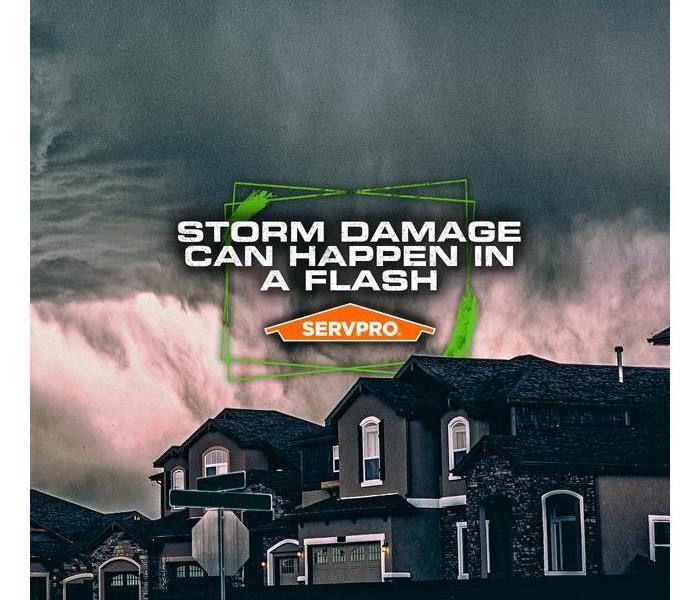 Whether flooding affects the interior or exterior of your home, team SERVPRO can help with knowledgeable technicians and advanced water removal tools.
Whether flooding affects the interior or exterior of your home, team SERVPRO can help with knowledgeable technicians and advanced water removal tools.
Navigating Flood Damage in Falmouth Homes with SERVPRO®
Situated along the southwest shoreline of Cape Cod, Falmouth provides easy access to pristine beaches, like Chapoquoit Beach, Surf Drive Beach, Falmouth Heights Town Beach, and Menauhant Beach, as well as scenic bike trails and delightful seaside communities. Visitors can explore scenic parks like Beebe Woods and Spohr Gardens or embark on outdoor adventures along the Shining Sea Bikeway. Falmouth exudes a lively arts and cultural ambiance, featuring galleries, theaters, and museums that exhibit the creations of homegrown artists and entertainers. Standout venues encompass the Falmouth Art Center, Highfield Hall & Gardens, and the Cape Cod Conservatory of Music & Arts.
The necessity for professional flood damage restoration in Falmouth becomes apparent as floodwaters indiscriminately devastate structures, belongings, and even the fundamental integrity of homes. In the midst of this upheaval, the demand for professional restoration assistance becomes a vital lifeline for homeowners endeavoring to regain control over their environments and restore normalcy to their lives. SERVPRO stands ready to guide homeowners through the daunting process of flood restoration. Floods bring with them a range of risks, such as pollutants, mold, and compromised structural integrity. SERVPRO crews, equipped with expertise and specialized tools, can evaluate these dangers, enact appropriate safety protocols, and minimize hazards.
SERVPRO's approach to contaminated water damage sites
- Removing excess water from carpets and other types of flooring using extractors
- Spraying an EPA-registered disinfectant directly on affected areas
- Removing standing silt and debris
When responding to a water damage situation caused by floodwaters, SERVPRO takes safety measures, including posting signs to warn of potential dangers and establishing a controlled work zone. Additionally, our crews wear PPE to shield them from the hazards present in the affected environment.
Water Removal Equipment for Flood-Damaged Properties
Lingering moisture presents numerous risks, including structural decay and the spread of mold, putting the safety and stability of flood-damaged properties at risk. Understanding the vital need for immediate intervention, SERVPRO's quick-response teams spring into motion, armed with cutting-edge extraction units like deep extraction tools and submersible pumps, crafted to remove water from impacted locations rapidly.
Further restoration actions for flood-damaged properties
- Mold Remediation
- Content Restoration
- Odor removal and deodorization
SERVPRO of Upper Cape Cod and The Islands stands as a beacon of hope when grappling with flood damage. Call us at (508) 888-5985. Faster to any size disaster™.
Get Reliable Water Restoration Services in Falmouth with SERVPRO
5/23/2023 (Permalink)
 Don't let storm damage go unchecked in your home.
Don't let storm damage go unchecked in your home.
SERVPRO’s Expert Team Provides Swift Water Restoration in Falmouth After a Storm
Whether from flooding, heavy rainfall, or a leaky roof, water damage from a storm can take a heavy toll on your property. Hiring professionals like SERVPRO for water restoration of your Falmouth home can help limit damage and speed up recovery.
SERVPRO techs quickly assess the damage and provide equipment and expertise during the water restoration of your Falmouth home. We take steps to prevent further damage to your property, such as installing tarps or boarding up windows to protect against rain or wind.
Removing the Standing Water During Flood Restoration
One of the most challenging tasks SERVPRO restorers face when they arrive at your flooded property is removing the standing water. As floodwater is often contaminated (category 3), techs must remove it quickly to prevent secondary damage.
SERVPRO techs use different types of water-extracting equipment to speed up water removal.
- Truck-mounted extractors are large, powerful extractors mounted on a truck, and techs use them for large-scale water extraction. They have a higher capacity and can extract water faster than portable extractors.
- Portable extractors are one of the most common water extraction equipment used in restoration. These machines are typically mounted on wheels, and techs can quickly move them from room to room.
- Trash pumps are especially useful during floodwater extraction as they can remove water that contains sediment and other debris.
Decontamination After Water Clean Up
SERVPRO techs use antimicrobials to decontaminate your property according to the IICRC S500 guidelines. We only use chemicals approved by the EPA during the decontamination process and strictly follow the local regulations regarding their usage.
SERVPRO techs apply antimicrobials only after the affected area has been cleaned and dried.
Call SERVPRO of Upper Cape Cod and The Islands at (508) 888-5985 for immediate help. Remember, We’re Faster To Any Size Disaster.
SERVPRO Provides Water Mitigation Services to Reduce Damage in Falmouth
12/6/2022 (Permalink)
 Let SERVPRO of Upper Cape Cod and The Islands fix it, Don’t stress it.
Let SERVPRO of Upper Cape Cod and The Islands fix it, Don’t stress it.
Quick Water Mitigation Reduces Extensive Secondary Damage in Falmouth – Call SERVPRO
Residents of Falmouth appreciate the fast water mitigation service provided by SERVPRO. When water leaks occur, water spreads everywhere, seeps into every nook and crack, and is absorbed by porous materials. Even hardwood floors can be damaged if exposed to water and high moisture levels for an extended period.
SERVPRO believes in being onsite to begin water mitigation efforts in Falmouth homes and businesses within four hours of your call. Our technicians know that if they can quickly remove the water and the moisture, they can prevent significant secondary damage to porous materials.
Carpets, underpads, subfloor material, hardwood flooring, drywall, and furniture/cupboards manufactured from particle board products can be damaged permanently if the water is not quickly removed.
Older carpets may delaminate and need to be replaced. Under-pad material soaks up water and causes the subfloor to lose structural integrity. The drywall expands and crumbles. Hardwood floor planks cup, buckle and warp if exposed to water for too long. Kitchen and bathroom cupboards made from particle board materials also disintegrate.
Mold can also infest a home in as little as twenty-four hours after a water leak. Mold likes to grow in dark warm areas with moisture and organic materials available, which are abundant in our homes.
SERVPRO utilizes high-capacity pumps, water extractors, vacuum floor mats, vacuum wands for difficult-to-reach locations, air movers, and dehumidifiers to rapidly remove water and moisture from your home. Our quick response and focused efforts reduce the probability of secondary damage significantly.
Our fast response to your water event can mitigate many of these issues. Don’t hesitate, call now.
Our services include the following:
- Water clean up
- Ceiling repairs from water damage
- Mold inspections, remediation, and removal
Call SERVPRO of Upper Cape Cod and The Islands for water mitigation and restoration services. We provide service to Falmouth and nearby areas. We can help 24/7. Call (508) 888-5985.
Controlled Demolition After Falmouth Flood Damage
8/10/2022 (Permalink)
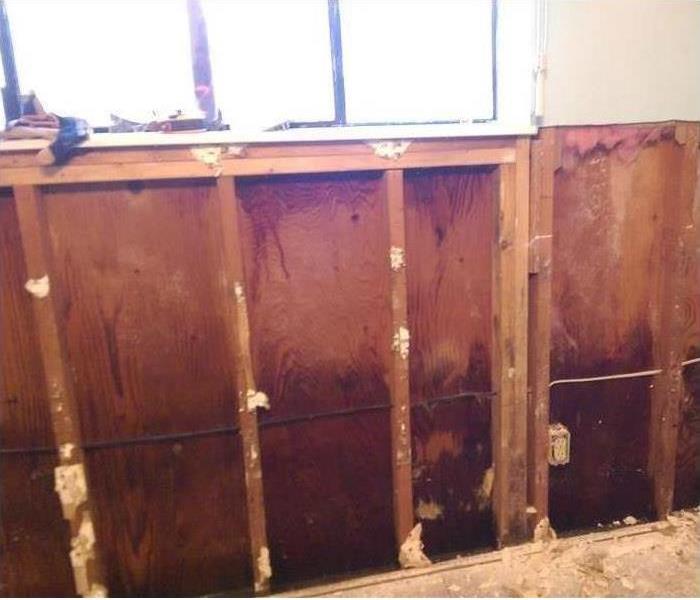 We aim to restore your property as quickly as possible, “Like It Never Even Happened.”
We aim to restore your property as quickly as possible, “Like It Never Even Happened.”
Certain Materials Can Be Ruined by Flood Damage
Flooding is one of the more complex and rapidly developing disasters impacting homes in the area. As violent and intrusive as these emergencies typically are, controlled demolition is often needed to protect the property from more significant harm and make restoration more efficient.
Recovering the Attic
Flood damage in Falmouth homes can often impact areas like the attic. Water penetration usually means damage to the roof, which must get repaired or rebuilt. Underlayment, insulation, damaged trusses, and other construction elements can often require removal to recover attics after flooding.
Cleaning the Basement
The basement level of your home is a typical area to experience intruding water for local homes and businesses. Falmouth properties contend a great deal with groundwater, and vulnerabilities in the foundation of residences can allow water to penetrate this lower level of the property directly. Demolition in this area might require wood framing, masonry foundation block, and subflooring for the main level.
General Building Materials
Even without one specific area of the house being targeted by flood damage, certain materials used in the construction of your home are sensitive to absorption and saturation. Some of these include:
- Flooring – Porous flooring absorbs flood damage from carpet to hardwood and can cause seams to bloat and warp.
- Baseboards – Trim around the base of the walls can be heavily impacted when wall systems fall victim to flooding.
- Drywall – Drywall gets used in the ceiling and wall assemblies and is one of the first materials to buckle underwater exposure due to its high porosity.
Many areas of a residence will become overwhelmed and even destroyed by flood damage. Because of the severity of these disasters, and the impact on the structure, our SERVPRO of Upper Cape Cod and The Islands professionals, respond fast to get mitigation and emergency services started. Call us today at (508) 888-5985.
The Coast Is Too Close to My Falmouth House
8/10/2022 (Permalink)
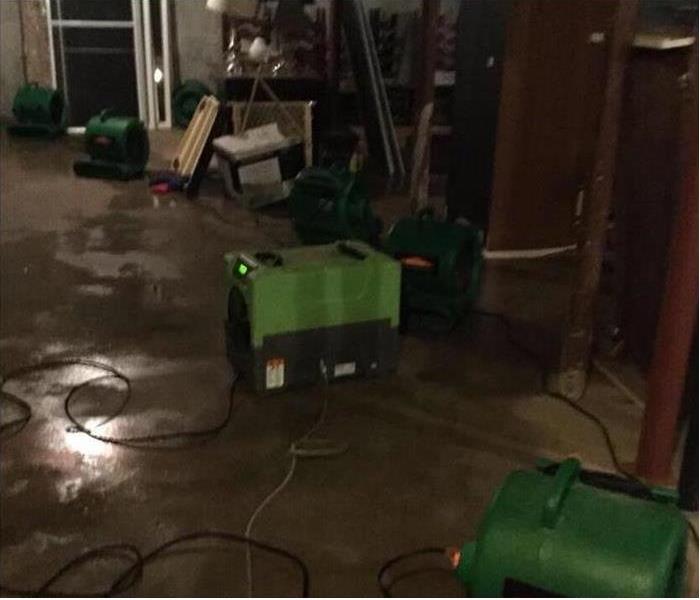 Let SERVPRO help you take care of your Falmouth flood damage.
Let SERVPRO help you take care of your Falmouth flood damage.
We Can Help You Through Your Falmouth Water Damage
Our coastal town of Falmouth is an enjoyable one. Its rich history and marine life are like no other in the country, as is our close-knit community. In the past years, we have continued to make history, but now it is more related to severe weather events that threaten our peace and leave us vulnerable to damage. Severe storms and downpours have left a significant number of homeowners in need of advice as they strive to restore their homes to mint condition. What many homeowners have come to realize is that a good insurance policy does not substitute for knowledgeable people guiding you in the restoration process.
SERVPRO works diligently to support our Falmouth community when there is flood damage. We understand the tribulation of seeing the water threaten your belongings; family heirlooms, pictures, and memories can fall victim to floodwaters, and it is your job to protect them. When disaster strikes, you can call our 24/7 hotline and let our Green Fleet arrive at your home as soon as it is safe. Keeping in mind any restrictions and guidelines imposed by local emergency workers, we begin to sort through the debris to minimize your losses.
Flood damage differs from a regular burst pipe in that the water entering your house can carry pollutants and bacteria. At SERVPRO, we recognize this critical distinction and design our work plan accordingly. Extracting water and removing any goods that can not be salvaged is a top priority for our team. We do this by understanding any environmental considerations in disposing of furniture or other porous materials and by bringing in potent pumps to remove the standing water and discard it through the appropriate sewage. A homeowner, does not need to know these intricacies; all you need to do is trust our knowledge and expertise as we restore your home.
Disinfecting your home is also of paramount importance. Eliminating organic matter requires a certain degree of education to apply targeted cleaning solutions to each surface. Once again, our SERVPRO crew knows the specific recommendations for each disinfecting job, and we count on up-to-date technology to be efficient in the process.
At SERVPRO of Upper Cape Cod and The Islands, we walk along your side when disaster strikes. Like you, we want to see Falmouth in its full glory and not ravaged by flooding. Let us be a part of the solution by calling (508) 888-5985 and let us leave your home "Like it never even happened."
What To Expect After Flood Damage to Your Sandwich Home
4/21/2022 (Permalink)
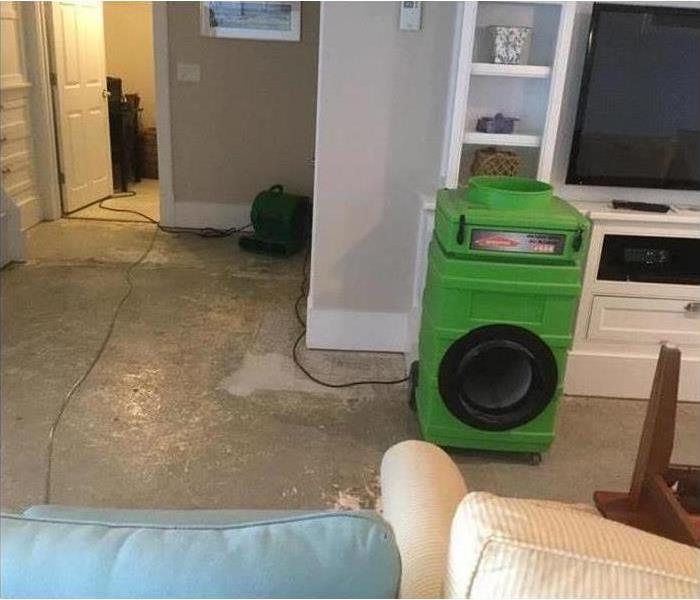 Falmouth homeowners love the effort and results that SERVPRO technicians provide during flood damage cleanup and restoration
Falmouth homeowners love the effort and results that SERVPRO technicians provide during flood damage cleanup and restoration
Two Flood Damage Scenarios Faced by Sandwich Homeowner
Properties can become flooded in gallons of water in as little as a few hours. These situations can either occur from external factors such as flash flooding or internal issues like malfunctioning drains or burst pipes. The resulting situation, a homeowner being ankle-deep in standing water, is the same. Circumstances involving flooding require immediate action to control losses and restore your property to normal.
Professional services can ensure that flood damage in your Sandwich home does not cause long-term issues with odor, microbial growth, or structural impact. As a homeowner, contacting SERVPRO to organize a restoration service is essential to the effective loss recovery procedure. External flooding issues should be left alone, as these situations can be Biohazardous waste scenarios due to contaminated groundwater.
Issues with burst pipes are often clean water emergencies, allowing a homeowner to carefully remove light furnishings from the affected area and onto the home's upper levels. This procedure can help preserve possessions while an experienced water restoration technician is on the way. However, water exerts extreme pressure on floors, walls, and cavities in the home; if you have doubts about the structural integrity of your property, wait for a professional.
Water incidents are time-sensitive, meaning that the longer the situation continues, the more damage it causes. SERVPRO technicians can deploy gas pumps to quickly remove standing water from the affected area and deposit it into a nearby sewer point. Once the water is removed, we can begin an inspection of items. In some cases, items can be cleaned on-site, others may need to be taken to an external cleaning facility, and some, unfortunately, may need to be discarded. SERVPRO technicians seek to restore items rather than replace them for the benefit of the homeowner.
In cleaning possessions, your technician can conduct initial tests on a small area to ensure that the item responds well to the cleaning solution and that no further damage is caused. Large furniture can be vacuum dried using water extractors or ventilation systems like box fans. Some fabrics may benefit from mechanical cleaning using Esporta washing machines. As your technician inspects the area, each item is earmarked and given an individual strategy for restoration. SERVPRO can significantly restore your storm-damaged home by keeping control of the small details.
Take back control of painful property damage by arranging a callout with our flood recovery team. Contact SERVPRO of Upper Cape Cod and The Islands at (508) 888-5985.
We Have Effective Removal Strategies in Falmouth After Flooding
4/5/2022 (Permalink)
 Contact SERVPRO for rapid flood damage mitigation to your Falmouth property.
Contact SERVPRO for rapid flood damage mitigation to your Falmouth property.
Flood Damage Falmouth – Dealing with the Damage
Anytime there is severe flooding, consumers are stressed, and worried about their homes, their contents, and where can their family reside until the house is ready to live in again. How can the family recover from such a significant loss, and who can complete all of the repairs? Many are overwhelmed in the first hours and days after a significant flood.
Fortunately, SERVPRO has dealt with many flood damage events in Falmouth and surrounding areas. We understand how important it is to quickly assess the situation and provide our clients with a road map to repair or reconstruct their homes. We also take the time to protect the building by providing board-up services as well as placing tarps on the roof if needed.
Developing a Recovery Plan
The first step for the SERVPRO crew chief once he has arrived on site is to introduce himself and his team. Next, the client is asked to show the flood damaged area. The crew chief also needs to know the customer's priorities, unique items that should be found and cleaned, and any concerns the customer has about the damage. The technicians also require space to offload tools and test equipment.
While SERVPRO cannot make any promises about what can be replaced or repaired until the insurance adjuster has also reviewed the situation, we can develop a plan to remove debris, clean your home and make emergency repairs. We also inspect the building for any safety hazards. Electricity, bio-hazards, mold, as well as pre-existing damage, are verified.
SERVPRO reviews the recovery plan with the insurance adjuster and our client, and then begins the necessary work to return your home to its original condition, "Like it never even happened."
We are a licensed Commercial Contractor, License # General: CS-108357, and can coordinate all of the repair and construction work, saving time and reducing total costs.
Call SERVPRO of Upper Cape Cod and the Islands at (508) 888-5985 for 24/7 service. We're Faster To Any Size Disaster.
How to Safely Cleanup Flood Damage in Sandwich Properties
2/2/2022 (Permalink)
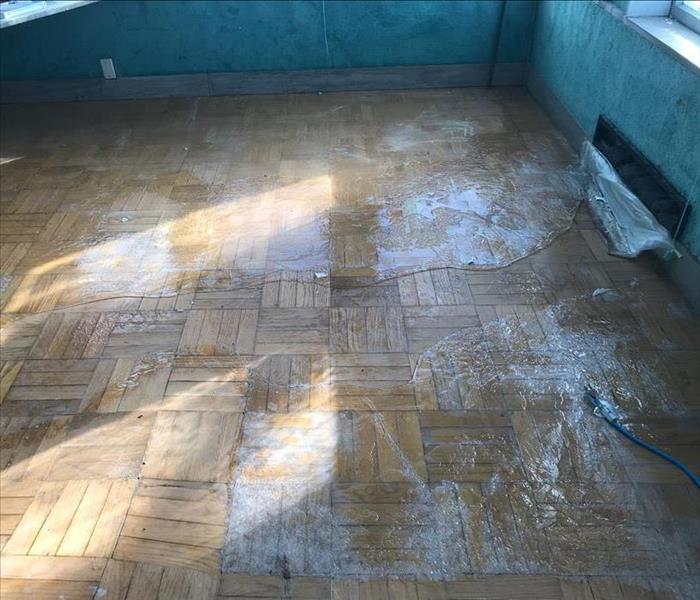 If you find yourself in need of assistance with water damage remediation, call SERVPRO at (508) 888-5985.
If you find yourself in need of assistance with water damage remediation, call SERVPRO at (508) 888-5985.
SERVPRO Brings Storm Damage Mitigation to Sandwich Homes
Tree limbs and flying debris from storms in the Sandwich area frequently result in structural damage. Snow and ice storms can bring down limbs and cause roof damage from ice dams. The end effect is that rain or groundwater can enter a home and quickly generate considerable damage.
Sandwich homes with flood damage often need repairs outside the property before the water cleanup efforts begin. SERVPRO technicians have the training and tools to make solid temporary repairs to areas of the home such as:
- Tarping over roofing damaged by tree limbs or high winds
- Broken window temp repairs
- Sandbagging around doorways to limit further water entry
SERVPRO technicians can assist with cleaning downed tree limbs as they perform the water mitigation service for the structure. A tree limb hitting the roof can cause problems from torn-off shingles to dents and crushing of the support. This situation can be particularly bad if the limbs have added extra weight from snow and ice.
When a roof or window has water damage, the technicians use their equipment to determine how much, if any, moisture penetrated the walls and surrounding area. Rain coming in through a broken window can ruin the walls, insulation inside, and flooring directly under the window. These areas need to be inspected carefully to see if it needs extraction and drying efforts from the techs.
The techs choose the proper size and type of water removal equipment to ensure that the maximum amount of moisture is removed. When needed, insulation and damaged walls can be opened to allow for airflow and complete drying.
SERVPRO of Upper Cape Cod and The Islands at (508) 888-5985 brings fast and thorough flood damage cleanup to Sandwich properties. Our trained and certified experts are available 24/7 to make the situation "Like it never even happened."
How Should Attic Flooding for Falmouth Homes Be Addressed?
1/13/2022 (Permalink)
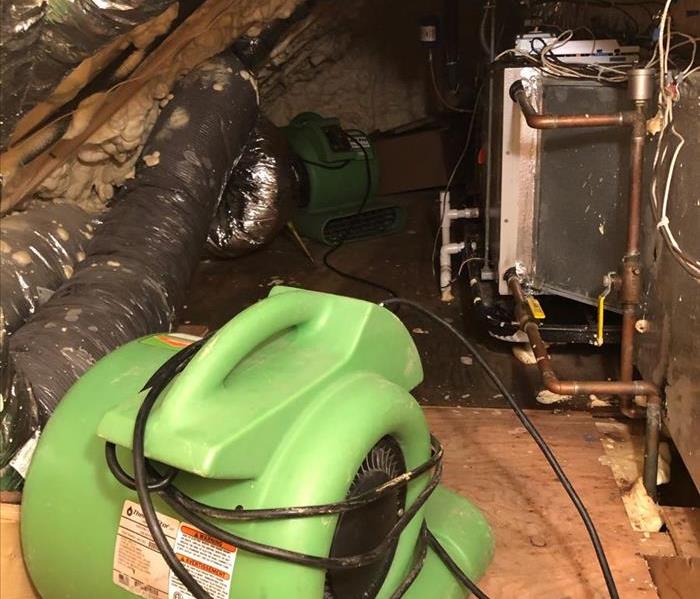 Attic flooding often results as part of a storm damage scenario. Call our certified SERVPRO technicians right away to assess the situation.
Attic flooding often results as part of a storm damage scenario. Call our certified SERVPRO technicians right away to assess the situation.
Our SERVPRO fast response allows mitigation to begin immediately in flood-damaged Falmouth residences.
Flooding is one of the disasters that can quickly and thoroughly destroy a home. Even without main level penetration, flooding in an area like the attic can have far-reaching impacts. As leading storm disaster relief professionals, our SERVPRO team answers three questions when we first arrive at a property with a flooded attic.
How Did the Attic Flood?
One of the big questions when establishing the approach to resolve flood damage in Falmouth homes is how the flood happened. Water penetration through a structure's envelope must be identified and temporarily resolved to prevent further flooding or damage while mitigation and restoration get underway.
What Structural Damage Resulted?
When flooding occurs through roofing materials, whether ice damming or storm damage, a structural compromise results. We have a general contractor license to help provide immediate board-up services and lasting full repairs once the flood damage inside the house has been mitigated.
Has the Water Spread to Other Areas?
Another considerable concern for responding professionals is where the water damage has migrated from the attic. Moisture can move through materials quickly, especially with standing water on unfinished attic materials doubling as the ceiling system of the floor below. Some of the signs our team looks for to determine migration beyond our moisture detection tools are:
- Ceiling staining
- Drips
- Moist materials
- Mold spotting
Resolving Present Flood Damage
As experienced flood restorers, we arrive with the necessary tools for extraction and drying. Attic flooding is less likely to involve contaminants, making the runoff cleanup less stringent, and more of the affected materials can be preserved.
Our SERVPRO of Upper Cape Cod and The Islands team can help with needed restoration and recovery when flooding impacts your home. Call today at (508) 888-5985.
What Are Restoration Obstacles for Falmouth Basement Flooding?
9/15/2021 (Permalink)
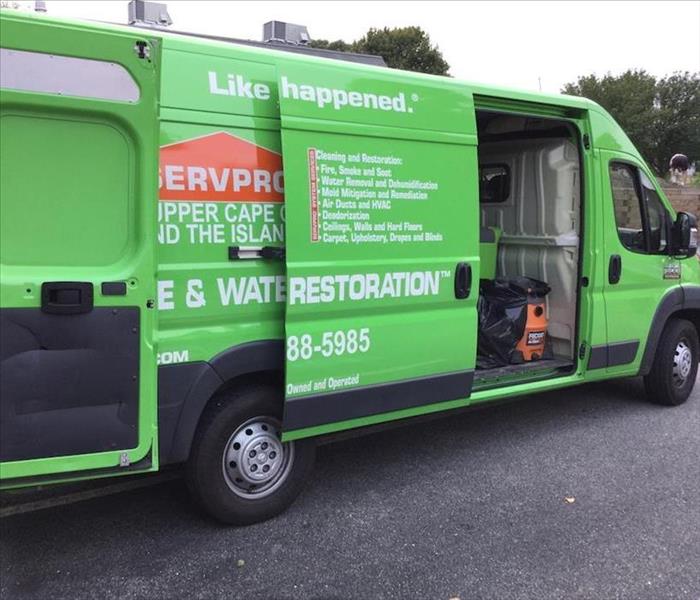 Flood damage to your home is no DIY project. SERVPRO technicians are trained and ready at a moment's notice.
Flood damage to your home is no DIY project. SERVPRO technicians are trained and ready at a moment's notice.
Standing Water in the Basement can be a Harmful Situation for Your Falmouth Property.
Severe weather events are not uncommon for the Upper Cape Cod area, making a storm response for situations like flood removal vital for area homes and businesses. However, standing water and spreading moisture is only part of the flooding concern, as properties can also suffer the possible contaminants and bacteria associated with this natural disaster.
Water Removal Services for Damaged Basements
Storm and flood damage for Falmouth properties can sometimes lead to standing water threats in areas like the basement. Acting quickly in these situations ensures that the appropriate measures get taken to remove this pooling and any solids or debris before greater harm results. Truck-mount pumps and trash pump units are typically the start of this extraction effort.
Repairing Penetration Points for Flooding
With a general contractor license, our SERVPRO professionals can do more to help recover a flood-damaged home. We have the means to provide repairs, controlled demolition, and reconstruction where they are necessary after a flood damaged property.
Treating Against Possible Mold Growth
Natural floodwater is known for possible contaminants and bacteria, which can amplify and increase the likelihood and severities of microbial colonization. Treating surfaces likely to experience mold growth before colonies form or become visible can often remove these organisms from hosting materials while simultaneously making the surface uninhabitable for further colonization. Some of the options for this include:
- Antimicrobial products
- Sporicides
- Biocides
- Disinfectants
Flooding of Falmouth basements is more common than many homeowners realize. Water penetration into this lower level can result in widespread damage and a pressing need for quality restoration services. Our SERVPRO of Upper Cape Cod and The Islands team can help you make flood loss situations "Like it never even happened," when you call (508) 548-1011.
How Does Sanitation Mitigate Flood Damage in Falmouth?
8/20/2021 (Permalink)
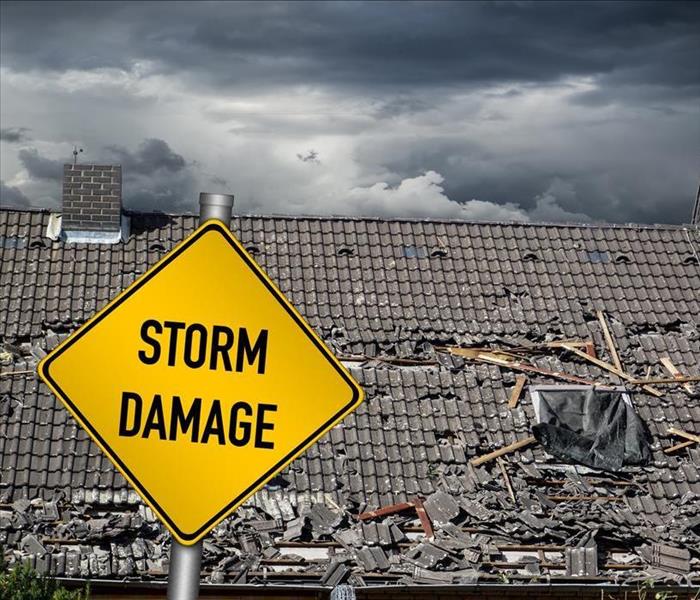 Storm and flood damage remediation is no DIY project. Call SERVPRO for fast and immediate service.
Storm and flood damage remediation is no DIY project. Call SERVPRO for fast and immediate service.
SERVPRO Biocides Curb Mold and Malodors from Falmouth Flood Damage
Flood damage brings more than just water into a given Falmouth property. An inch of water is enough to cause over $27,000 in damages. Cleanup of the debris, chemical residues, sewage, microbes, and pests that come with floodwaters renders a do-it-yourself cleanup solution unsafe for homeowners. Fortunately, there is a team that can assist with these disasters.
SERVPRO professionals perform flood damage cleanup for Falmouth residences 24 hours a day, seven days a week. This Institute of Inspection, Cleaning and Restoration Certification (IICRC) certified firm deploys EPA-registered antimicrobials to address bacteria and odors from floodwater debris and mold.
SERVPRO Sanitation Methods Salvage Flooded Properties
In a flood scenario with standing water present, SERVPRO can implement OSHA-approved biocides with pump or trigger sprayers right away. Meanwhile, extractors and submersible sump pumps eliminate the excess water. This firm has access to over 100 proprietary cleanup solutions designed to mitigate microbes and malodors.
Treatment steps for flood-damaged surfaces include:
- Applying sanitation solutions directly to salvageable flooring. Flood-damaged carpet and pad requires removal and replacement.
- Careful cleaning of home contents, either on-site or in a SERVPRO warehouse after a pack-out
- Establishing negative air pressure to prevent the spread of mold spores and other odor-causing microbes
- Wet cleaning for salvageable walls entails the manual application of cleaning solution from bottom to top, followed by a rinse solution and towel-drying
SERVPRO of Upper Cape Cod and The Islands performs fast-acting mitigation and restoration that makes homes feel “Like it never even happened.” Call (508) 548-1011 at any time of the day or night for service.
Can Flood Removal Occur in a Sandwich Basement with a Broken Sump Pump?
6/21/2021 (Permalink)
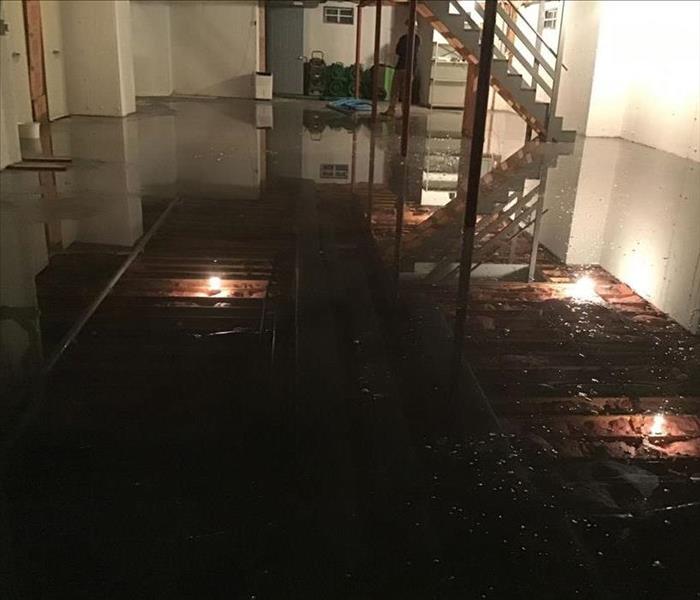 When your Sandwich area basement suffers a flooding--Call SERVPRO for water removal
When your Sandwich area basement suffers a flooding--Call SERVPRO for water removal
SERVPRO has Specific Equipment to Handle Deep Standing Flood Water in Sandwich Properties
When heavy storms hit the Sandwich area, and the sewer drains get overwhelmed, sometimes the floodwater can back up into homes and businesses. This situation can get remedied rapidly if the sump pump is in working order and the drainage system is still flowing. But what if it isn't?
SERVPRO performs rapid flood removal in Sandwich properties no matter how much basement flooding has occurred. The techs have both the training and equipment to remove it. When the storm drains are overwhelmed by heavy rains, the techs can dispose of the wastewater in separate receptacles.
Many basements tend to be catch-alls for storage; moving boxes and articles away from the water needs to occur early in the flood restoration services. SERVPRO techs work quickly to get items up and off the floor, so the extraction goes more rapidly and protects contents.
When the homeowner has a finished basement, floodwater can do greater damage than tile. The glue-down carpet tends to delaminate and requires removal and disposal, leaving a concrete slab substrate to dry. In cases where the basement has finished walls, the sheetrock over the cinder block may deteriorate rapidly and require more than flood cuts but complete removal to dry the interior. Fortunately, this SERVPRO location has a general contractor license #CS-108357 and can offer any water damage repairs needed, from re-installation of flooring to re-finishing a basement.
Commonly Used Professional Water Removal Equipment and Applications
- Manual tools
- Submersible pumps
- Trash pumps
SERVPRO of Upper Cape Cod and The Islands at (508) 888-5985 serves the Sandwich community with 24/7 availability of fast, efficient flood removal.
What Should a Falmouth Homeowner Do First After Flood Damage?
6/6/2021 (Permalink)
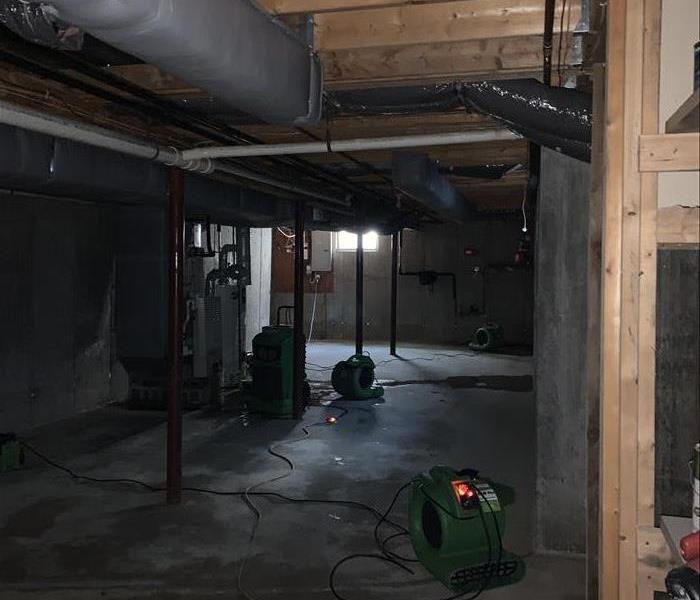 SERVPRO dries contaminated flooded Falmouth basements with advanced equipment
SERVPRO dries contaminated flooded Falmouth basements with advanced equipment
SERVPRO Techs Are On-Call 24/7 for Flood Restoration in Falmouth Properties
Interestingly enough, landlocked states are eight times more likely to receive flood damage, according to FEMA. While not landlocked, Falmouth properties, with their proximity to Buzzard Bay and Nantucket Sound, are at risk of flood damage when heavy storms roll into the area. Knowing what to do can assist in saving a house and contents from ruin.
SERVPRO arrives rapidly for a Falmouth flood damage remediation job, but there are things homeowners can do before the techs arrive on-site. If a portion of the home is affected, such as a basement, close off the entry points to avoid cross-contamination in other home areas. When the entire home receives floodwater, evacuate people and pets, until SERVPRO arrive. Typically, the water is considered black water. Plus, the technicians have protective clothing that inhibits the chances of touching the floodwater during the extraction and disposal process.
Things Not to Do Before Flood Restoration Begins
- Do not come into contact with the water
- Wait to remove important items; SERVPRO can handle it
- Do not test electronics that took on floodwater
- Turn off the electricity if it is safe to do so if water is close to outlets or fixtures show signs of water damage such as water inside of light bulbs
SERVPRO of Upper Cape Cod and The Islands at (508) 888-5985 serves the Falmouth area with 24/7 availability for flood damage cleanup and restoration services.
What Contaminants Might Be Present with Basement Flooding in Sandwich?
4/11/2021 (Permalink)
 Flooding can quickly damage your home. Contact our certified technicians 24/7 for remediation services and water removal.
Flooding can quickly damage your home. Contact our certified technicians 24/7 for remediation services and water removal.
Flood damage presents unique challenges after a storm in Sandwich – Hire SERVPRO for basement flooding cleanup!
When looking at the town of Sandwich, Massachusetts, you may not think there is much to it. Smaller in size than many tourist stops in the state, Sandwich happens to be the oldest town in all of Cape Cod. Throughout the historic district in town, you will find a beautiful town hall situated by Dexter Grist Mill, making for excellent photo opportunities.
Indigenous peoples for thousands of years initially occupied cape Cod. The town of Sandwich was settled in 1937 by a group of Europeans from Saugus under permission from the Plymouth Colony. There are many extraordinary historic homes located in the town of Sandwich, including:
- Benjamin Holway House, originally built in 1789
- Benjamin Nye Homestead, constructed in 1678
Sandwich, Massachusetts, was also home to an early Quaker settlement. Today, the town still plays host to annual Quaker meetings.
There are Plenty of Beautiful Natural Attractions to Experience in Sandwich, Massachusetts
Due to the location of Sandwich, you have several incredible coastal attractions to take in. Whether you want to explore a local beach or take in the sights from a State Reservation, there is a lot to put into your day trip schedule, including:
- Sandy Neck Beach – Situated on Sandy Neck Road, this is a lovely little stretch of scenic beachfront. As part of the charm that comes from 'all that is Cape Cod,' this is a lovely spot to enjoy hiking, birdwatching, or simply soaking up the sun and salty sea air.
- Scusset Beach State Reservation – This little spot is located on Scusset Beach Road, where you will find a strip of beach with clean sand for spending time with a book or watching the kids building sandcastles. There is also a rocky jetty that is just right for exploration to look for crabs or to cast your line to try your hand at fishing.
- Green Briar Nature Center and Jam Kitchen – Located on Discovery Hill Road, this destination features lovely nature trails, whimsical gardens, and an on-site jam-making kitchen. Browse the gift shop, take home so jam, or snap a few pictures of the animals on the grounds.
Basement Flooding After a Sandwich Storm Brings Pesky Microbes – SERVPRO Can Handle Your Flood Damage Cleanup Needs!
Emergency services water damage assistance is critical once your basement gets flooded after a major storm rolls through Sandwich. Not only could there be a leaking roof from storms, but the flood water coming into your basement is loaded with potential contaminants. Letting this fester for too long brings harmful microbial growth.
Flood damage in Sandwich is best left to the skilled technicians at SERVPRO so you can ensure you get the results you need. We work to:
- Facilitate water clean up fast while reducing relative humidity to below 60% to help inhibit mold growth.
- Arrive at your property quickly to start water removal services to cut down on costly secondary damage.
- Wear the appropriate personal protective equipment (PPE)
- Put containment barriers in place to limit the tracking of contaminants into unaffected zones
Call SERVPRO of Upper Cape Cod and The Islands at (508) 888-5985 when you need prompt flood damage restoration after a recent storm.
What Should I Do When Storm Damage Impacts My Home?
3/2/2021 (Permalink)
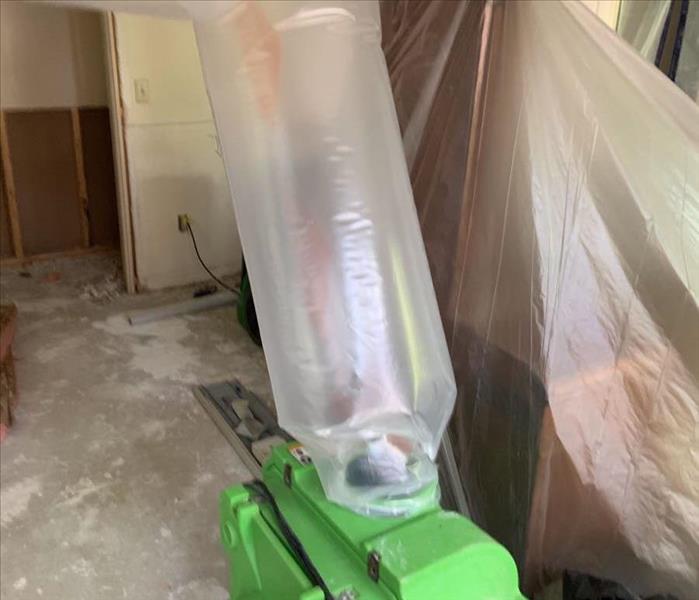 This advanced method of using air scrubbers and lay-flat poly ducts can facilitate the drying of a structure in Falmouth after a storm--SERVPRO can do
This advanced method of using air scrubbers and lay-flat poly ducts can facilitate the drying of a structure in Falmouth after a storm--SERVPRO can do
SERVPRO Can Remediate the Storm Damage in Your Falmouth Home!
Falmouth was first settled by English colonists in 1660 and has grown to become the second-largest municipality in Cape Cod. The city was named after a port in England, Falmouth, Cornwall. Today, it has a population of 31,531, according to the 2010 census.
Falmouth Facts:
Early in its history, the settlement became known for:
- Farming
- Salt Works
- Whaling
- Sheep Husbandry
Falmouth Attractions:
- North Falmouth Village
- Falmouth Village Green
- Waquoit
North Falmouth Village:
North Falmouth Village is a heritage site constructed in the 1800s. The townsfolk traditionally used the area for fishing and for gathering together in celebration. Many of the historic districts of Falmouth are excellent areas for tourism.
Falmouth Village Green:
The Village Green is centered around the triangular green of Main Street. It is a historic site and has been the town center since 1756. Many people travel here to see the traditional colonial layout of a traditional settlement.
Waquoit:
The Waquoit Historic District encompasses the village of Waquoit in southeast Falmouth. It has more than 80 properties of historical value and was placed on the National Register of Historic places in 2004.
When Storm Damage Interrupts Your Life:
Living so close to the ocean can make it easy for storm damage to affect your Falmouth home. An intense storm can bring water, wind, and even debris to your door and cause trouble. Picture winds more than fifty miles an hour blowing signs, tree branches, and yard decor around your neighborhood. A mighty gust of wind could throw open the door of your home and allow storm damage inside. Storm damage like this could enable:
- Blackwater to rush into your home
- Carpets to become waterlogged
- Mud and muck to cover interior rooms and furnishings
Blackwater is a serious issue and should not be ignored. It can contain biohazards, petroleum, gas, and other harsh chemicals. Should it impact the rugs in your home, they cannot be remediated as there is no way to ensure safety. Our team understands the health risks of contaminated groundwater and removes any residual amount as we begin the cleanup and restoration.
How Can SERVPRO Help Me?
Our technicians are IICRC-certified (Institution of Inspection, Cleaning and Restoration-Certification) and can clean up the mess in your home, no matter the size. We're Faster to Any Size Disaster, and our technicians are trained to use state-of-the-art advanced equipment for the job. It is always our goal to make you feel "Like it never even happened."
To clean up and remove storm damage, our technicians can:
- Use wet/dry vacuums to remove excess puddles of water
- Set up flood drying mats to draw moisture from hardwood floors
- Clean your property with industrial-grade disinfectants and detergents
If your home has been struck by storm damage, never hesitate. Get help today by calling SERVPRO of Upper Cape Cod and The Islands at (774) 252-7376. We're always ready to help you!
Find the Perfect Holiday Ornament at Sandwich Glass Museum
11/8/2020 (Permalink)
 SERVPRO says feel safe during the Holiday Season in Sandwich
SERVPRO says feel safe during the Holiday Season in Sandwich
It Is Time for Sandwich Glass Museum's Annual Glassblowers Christmas
It is the time of year for festive ornaments, and what could be better than something beautiful and locally crafted? Glassblowing plays a massive role in Sandwich's history, and the Glass Museum offers exhibits and demonstrations all year round. Every year, they put on a festive fare where visitors and residents alike can marvel at the local glass-making talent and purchase eye-catching holiday ornaments.
- View the decorations displayed on a forest of festive trees.
- Delight at the annual exhibition – this year's theme is the glass menagerie.
- Entry is free, but you will need to purchase a ticket to enter the rest of the museum.
The Glassblowers Christmas takes place at the Sandwich Glass Museum on Main Street and starts on 14 November. You are sure to find an ornament that will look great in your home or something for the perfect gifts.
SERVPRO of Upper Cape Cod and The Islands hopes the weather will hold for anyone traveling to the exhibit! However, if you run into trouble with storms and need water extraction, please give us a call at (774) 252-7376.
What Needs to Get Done After Storm Flooding in Falmouth?
10/26/2020 (Permalink)
 We are available 24 hours a day to send a crew out to begin the assessment phase.
We are available 24 hours a day to send a crew out to begin the assessment phase.
Falmouth Property Owners Know that Flood Damage Happens Without Warning – Look to SERVPRO for Skilled Restoration
Once flooding occurs inside your Falmouth home, multiple layers of damage can arise. You could have issues with flooring, carpets, walls, and even your home’s structural elements. It is also common to have some electrical issues after a flood, which is why the safest bet is calling in trained water restoration technicians (WRT).
Where Do I Start?
Right after the storm, you need the right team to handle flood damage in Falmouth, including emergency water extraction. SERVPRO begins with assessing your property to determine which equipment is best so that cleanup and drying may begin. The home repairs that your home might require could be extensive, but we have contractors that can handle controlled demolition and finish off your interior back to preloss condition.
What About Mold?
Any floodwater left standing for too long creates the ultimate atmosphere for mold growth. Our crew understands best practices to search for hidden moisture pockets. We also work to treat surfaces throughout your home to facilitate mold remediation.
Why Should I Call Skilled Restoration Technicians?
When you enlist our help at SERVPRO, we provide:
• Years of experience in the restoration industry
• Education and training via the Institute of Inspection Cleaning and Restoration Certification (IICRC)
• Industrial-grade equipment such as extraction tools, air movers, dehumidifiers, and more
• EPA-registered cleaning agents with anti-microbial and anti-bacterial properties
Because floodwater often contains contaminants, our crew is careful to test the water and treat surfaces throughout the restoration process. Exposure to the microbes found in floodwater, also known as black water, can lead to health effects if not handled carefully. All of our restoration technicians wear personal protective equipment to ensure safety throughout the project. We also wear foot coverings and block off zones to keep contamination from getting tracked to unaffected areas of your home.
Do you need prompt, reliable assistance to handle the flood damage in your home after a storm? Call SERVPRO of Upper Cape Cod and The Islands at (508) 888-5985. We are available 24 hours a day to send a crew out to begin the assessment phase.
What Does a Professional Flood Cleanup Involve in Falmouth?
8/25/2020 (Permalink)
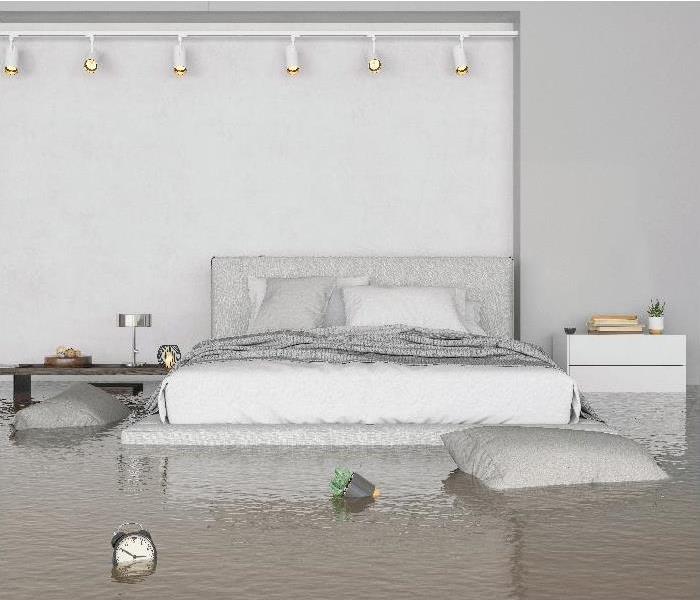 Contact your neighbors at SERVPRO of Upper Cape Cod and The Islands at (508) 888-5985 if you ever need help dealing with flood damage.
Contact your neighbors at SERVPRO of Upper Cape Cod and The Islands at (508) 888-5985 if you ever need help dealing with flood damage.
Flood Cleanups in Falmouth Generally Involve Standing Water Removal, Interior Drying, Surface Disinfecting, and Odor Neutralization.
Remediating flood damage in Falmouth and returning impacted homes to their pre-flood conditions requires professional assistance. It takes expert knowledge concerning biohazards and restoration techniques, as well as high-tech disinfection and deodorization tools.
SERVPRO, a Falmouth flood damage remediation service, knows its neighborhood well and understands the yearly weather-related challenges it faces. Our hometown, like the rest of Cape Cod, is known for its picturesque maritime landscapes. Numerous nearby beaches and other natural environments, coupled with pleasant summer weather, make the area a paradise for sea lovers and outdoorsmen alike. Unfortunately, the Cape also routinely suffers the effects of strong coastal storms. These powerful weather systems impact the region year-round in the form of hurricanes and Nor’easters. The torrential rains and winds these storms usually bring often lead to massive flooding.
What High-Tech Equipment Does SERVPRO Have to Effectively Resolve My Flooding Issue?
Our trained technicians are equipped with all the latest tools of the remediation trade. They can employ all the most advanced water extractors, drying appliances, disinfection devices, and deodorizers to resolve your flood-related problems in as little time possible. Some of the impressive gear our experts use are:
• Portable and truck-mounted extractors that can rapidly remove gallons of water from your home
• Powerful submersible pumps that can speedily and consistently help extract large volumes of standing floodwaters
• Technologically advanced air blower-dehumidifier-Injectidry system networks to quickly dehumidify interior air and dry out even the most difficult-to-access areas
• State-of-the-art ultra-low volume (ULV) and thermal foggers that can disinfect and deodorize affected surfaces/spaces with EPA-approved aerosolized chemical agents
This commercial-grade equipment is one of the many factors that make SERVPRO more effective at flood damage remediation than its competitors.
While there is no way to escape the threat of powerful New England storms and the flooding they often bring, there are local services that can help you overcome the destruction they cause. Contact your neighbors at SERVPRO of Upper Cape Cod and The Islands at (508) 888-5985 if you ever need help dealing with flood damage.
What Can I Do To Protect Documents From Flood Damage In North Falmouth?
8/7/2020 (Permalink)
 If you are concerned about flood-damaged documents, give SERVPRO of Upper Cape Cod and The Islands a call.
If you are concerned about flood-damaged documents, give SERVPRO of Upper Cape Cod and The Islands a call.
North Falmouth Owners Want To Know Their Documents Are Safe From Flood Damage
Residents of North Falmouth know that relevant paperwork is all too easy to lose or damage. Most of us have at least a handful of vital documents that need to be kept safe, such as birth certificates or insurance documents. But have you ever thought about keeping your records from harm in the event of a flood?
Flood damage in North Falmouth affects every part of the home. Depending upon the severity of the flood, homeowners could find themselves facing warped floors, damaged drywall, soaked carpets and chairs, and water-damaged documents. No one wants to deal with flood damage, but thankfully SERVPRO of Upper Cape Cod and The Islands is here to help.
One primary concern in the event of a flood is the loss of irreplaceable documents. So what can local homeowners do?
Which documents should I protect from flood damage?
There are some important papers which you should always protect if you can, including:
Household documents – mortgage papers, car lease or ownership papers, and insurance policies
Medical documents – medicine scrips, vaccination records, and health insurance information
Personal records – birth, marriage, and adoption certificates, degrees, passports, and social security cards
Pet records – adoption or purchase certificates, vaccination records, and microchip numbers
Financial documents – bank details, wills, IRS details, bank statements, tax records, 401(K) details, and receipts
Are there any other details I should add?
The above list covers the necessary paperwork you should protect. However, SERVPRO recommends writing down the following details and adding them to your papers:
• Doctor contact details
• Emergency contact details such as families and friends
• Contact information for utility providers
• Photocopies of credit cards and drivers licenses
You can also keep precious family photo albums with your essential documents. You might also consider backing important electronic files up onto flash drives and keeping those with the collection.
What is the best way to keep my documents safe?
It's a good idea to gather all your essential information together as soon as possible before disaster strikes. SERVPRO suggests investing in waterproof storage boxes or cabinets for your valuable personal effects. Please be sure to choose waterproof units rather than just water resistance. If you can purchase storage that is fireproof as well as waterproof, that's even better.
• Keep your boxes or cabinets away from windows and doors, where water can enter your home. Store them on shelves at least six inches from the floor, if possible, and preferably on your home's upper story.
• You might also consider renting a safe deposit box outside of the home for specific documents that you do not require access to often, such as retirement funds, insurance policies, and investments.
• Take photocopies of all essential documents, and put extra copies on a flash drive. Always have a set of copies stored securely away from the original set.
Can I do anything to prevent floodwater from entering?
• Prevention is always better than cure, so you must try to prevent flood damage from occurring. Maintain your home regularly and take care of any broken gutters, missing roof tiles, or worn door and window seals you find.
• Keep your pipes and gutters clean. Remove leaves and gunk from your gutters, especially after a downpour, and keep your pipes well protected to prevent freezing and breaking.
• Take good care of your plumbing system. Check for leaks or drips, and deal with any issues as soon as you find them – do not delay.
• Look after your appliances – make sure the tubes and connectors are in good condition at all times.
Can SERVPRO help with my documents?
If you are worried about flood-damaged documents, call SERVPRO. We’re Faster to Any Size Disaster, and we have technology that can help restore damaged materials.
Our technicians will examine your papers and give you an honest assessment to which can be saved and which cannot. For those that can be saved, we employ techniques such as vacuum freeze-drying and gamma irradiation cleaning to preserve and cleanse certificates, papers, books, policies, and more. Our vacuum freeze-drying method is the same one that is used by the Library of Congress.
We can also help you digitize your documents so that you can access them more easily in the future, and you will have the peace of mind that comes with knowing your documents are properly backed up.
Our teams also take care of every other aspect of flood damage restoration, from water extraction and cleaning of all soft furnishings to drying and deodorizing. We are available 24/7, which means there is always someone on standby to help you in the event of a disaster.
If you are concerned about flood-damaged documents, give SERVPRO of Upper Cape Cod and The Islands a call at (508) 888-5985.
What Kinds of Storm Events Inflict the Consequence of Flooding in My Falmouth Home?
6/8/2020 (Permalink)
 Call us for assistance of any kind!
Call us for assistance of any kind!
Falmouth Flood Damage Can Have Many Storm-Related Causes -- SERVPRO Prepares to Help for Any Scenario
As the severe storm season starts to ramp up in the Atlantic, you are wise to consider how to ready yourself for the many different ways you might experience its impact. Regardless of how the floodwaters invade your Falmouth spaces, the overall goals are the same:
• Get the water out fast
• Dispose of it lawfully
• Clean away debris and residues
• Disinfect
• Dry affected materials
How Can a Restoration Company Help with Safety and Security?
Homeowners who have never used our services might be surprised at the emphasis we place on safety assessment and securing your dwelling. Falmouth flood damage from storm activity can include significant exterior breaches, roofs, windows, and siding taking hits from wind and debris, and exposing your home to the elements. Our well-trained and equipped crews board and tarp up holes while managers assess the interior for safety hazards like a slip, trip, and fall; electrical shock; and the imminent collapse of walls and ceilings where building cavities are full of rainwater.
Is There the Possibility of Saltwater Flooding My Home?
Our community's location with Buzzards Bay to the north and Vineyard and Nantucket Sounds to the west and south put homes at risk of storm surge mixing in with the torrents of rain. Saltwater flooding complicates remediation somewhat, with freshwater flushing possibly a recommendation before water removal completes. Saltwater is a contaminant, exposing metals to heightened oxidation risk, concrete to slow but steady deterioration, and wood structures to delignification. Extra care needs to be taken when saltwater and electrical currents cross paths, as the salt increases conductivity.
Am I Responsible for Proper Disposal of Contaminated Flood Waters?
Flooding issues are already complicated, and then issues surrounding the hazardous substances mixed or dissolved in the floodwaters arise. SERVPRO is familiar with local rules and regulations about the lawful and safe disposal of contaminated waters flooding inside your home. Chemicals, insects, animals, sewage, and industrial waste are among the potentially dangerous substances contained in overland and flash flood water. We contain the dirty water and take all steps necessary to discard it as hazardous waste. Rely on our experience and vigilance in remaining current with current rules. We obtain needed permits and document how we managed the water.
How Do I Get to Water that Migrates into Building Cavities?
When large amounts of water invade your home, it is a dynamic force, seeping through cracks and crevices. Spaces in cinder blocks, between walls, under floors and cabinets, and more can hide standing water and deflect your attention from moisture absorbed into structures. Our technicians use moisture detectors and meters and thermal imaging cameras to seek out and locate trapped water. If needed, our crews use controlled demolition to release water and gain access for drying efforts. Flood cuts, which take out several inches of a wall from the floor to above the waterline, and drilled holes under baseboards and in mortar joints, create ways to drain and dry wet recesses.
Is Gutter and Downspout Maintenance Worth the Hype?
Consider the dramatic scenarios with which our coastal community copes during "training" rainstorms and intense timeframes like a hurricane and Nor'easter seasons. Is it worthwhile to spend any time worrying about the drainage system for your roof when these events appear cataclysmic? Periodic reminders in the media, and maybe from family, neighbors, and friends, push the idea that gutters and downspouts are crucial in the fight to keep water from flooding your home. Are you convinced?
What Do Gutters and Downspouts Do?
Even in ordinary rainstorms, a dependable drainage system at your roofline helps move vast quantities of precipitation off your house and direct it at least ten feet away from your foundation. Just because rain is unaccompanied by high winds does not eliminate the flooding danger it poses to your home. If water falling over the entirety of your roof sheets down directly next to your foundation, it makes its way through the stone, brick, concrete, or cinder block and into your basement.
What Steps Do I Take to Avoid Gutter and Downspout Failure in the Future?
Get into a routine. Gutters can fill with roof granules, leaves, sticks, and other debris. These impediments to free-flowing rainwater must be removed regularly. Check on the condition of the components, fasteners, and connections, and immediately arrange to replace, repair, and upgrade.
Is It Feasible to Find a Flood Damage Restoration Contractor that Can Do It All?
As our crews work through the debris cleanup, contaminated water removal and disposal, residue remediation, disinfection, and structural drying, you often are not back to preloss condition. Structural damage, including planned demolition to release hidden water and enhance drying efforts, remains. Rather than shaking your hand and referring you to another contractor for rebuilding, we can help you with repairs, replacement, and reconstruction, licensed in the state of Massachusetts.
Trust the team at SERVPRO of Upper Cape Cod and The Islands to stand with you and implement successful strategies to bring you out of a storm-related flood situation successfully. Call us for assistance of any kind at (508) 888-5985.
We Got Hit with a Major Storm in Falmouth, How Can I Clean Up the Floodwater?
5/17/2020 (Permalink)
 Give us a call at (508) 888-5985, and we will deploy a team to make it “Like it never even happened.”
Give us a call at (508) 888-5985, and we will deploy a team to make it “Like it never even happened.”
SERVPRO Offers Reliable Flood Damage Restoration to Bring Your Falmouth Property Back to Pre-Loss Condition
If your home suffers extensive storm damage, you need a team that can spring into action fast. This is especially true when flooding is involved, as these waters come with a variety of debris and contaminants. SERVPRO is available 24/7 in emergencies like this to help you get the prompt water removal and cleanup; you need to return your interior to pre-flood loss condition.
Why is SERVPRO the Best Choice for Flood Restoration?
Our Green Fleet is stocked with the latest equipment and products necessary to help us provide fast, efficient help when your home suffers flood damage in Falmouth. You can count on us for:
• Prompt Response: Our crew arrives in as little as four hours ready to get to work
• Documentation: We know it is a stressful time, so we take care of the paperwork for you to ensure that the project goes as smoothly as possible with your insurance company
• Equipment: The trucks are filled with water extraction tools, moisture detection equipment, and EPA-registered cleaning agents provide our customers with professional results.
What Can I Salvage After the Flood?
Plenty of damage happens after a storm rips through the Falmouth area, but our skilled technicians work quickly to limit additional damage. We ensure your home is free of moisture that can bring on mold and mildew, as well as foul odors. Everything gets cleaned and disinfected thoroughly so that your interior is safe for your family to go about your daily life.
With the attention to detail and specialized planning that SERVPRO of Upper Cape Cod and The Islands has to offer, you can get back to your routine faster after flood damage. Give us a call at (508) 888-5985, and we will deploy a team to make it “Like it never even happened.”
For more about Falmouth click here.
We Arrive As Quick As Possible To Begin Your Falmouth Flood Damage Restoration
1/21/2020 (Permalink)
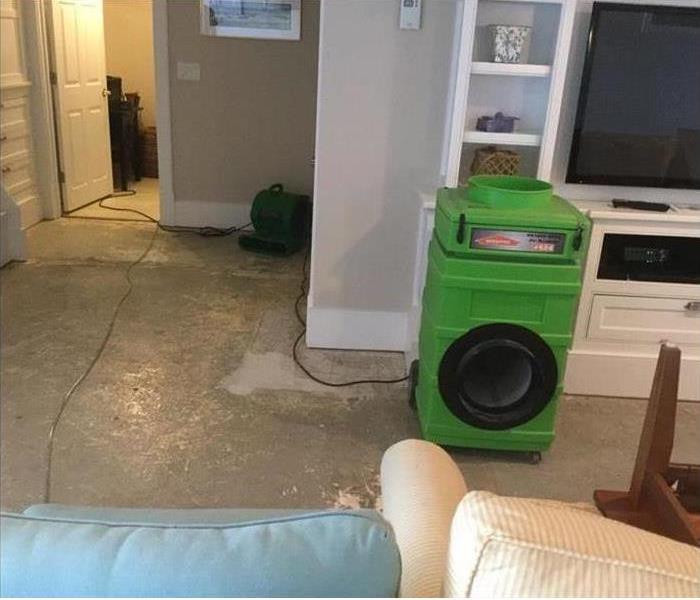 We have the state of the art equipment necessary to properly restore your home like this HEPA filter shown in the photo.
We have the state of the art equipment necessary to properly restore your home like this HEPA filter shown in the photo.
Flood Damage Falmouth – Dealing with the Damage
Anytime there is severe flooding, consumers are stressed, worried about their homes, their contents, and where can their family reside until the house is ready to live in again. How can the family recover from such a significant loss, and who can complete all of the repairs? Many are overwhelmed in the first hours and days after a significant flood.
Fortunately, SERVPRO has dealt with many flood damage events in Falmouth and surrounding areas. We understand how important it is to quickly assess the situation and provide our clients with a road map to repair or reconstruct their homes. We also take the time to protect the building by providing board up services as well as placing tarps on the roof if needed.
Developing a Recovery Plan
The first step for the SERVPRO crew chief once he has arrived on site, is to introduce himself and his team. Next, the client is asked to show the flood damaged area. The crew chief also needs to know the customer's priorities, unique items that should be found and cleaned, and any concerns the customer has about the damage. The technicians also require space to offload tools and test equipment.
While SERVPRO cannot make any promises about what can be replaced or repaired until the insurance adjuster has also reviewed the situation, we can develop a plan to remove debris, clean your home and make emergency repairs. We also inspect the building for any safety hazards. Electricity, bio-hazards, mold, as well as pre-existing damage, are verified.
SERVPRO reviews the recovery plan with the insurance adjuster and our client, and then begins the necessary work to return your home to its original condition, "Like it never even happened."
We are a licensed Commercial Contractor, License # General: CS-108357, and can coordinate all of the repair and construction work, saving time and reducing total costs.
Call SERVPRO of Upper Cape Cod and the Islands at (508) 888-5985 for 24/7 service. We proudly serve Edgartown, West Tisbury, and surrounding areas. We're Faster To Any Size Disaster.
See more about Falmouth.
We Have The Effective Removal Strategies In Falmouth After A Flood
1/8/2020 (Permalink)
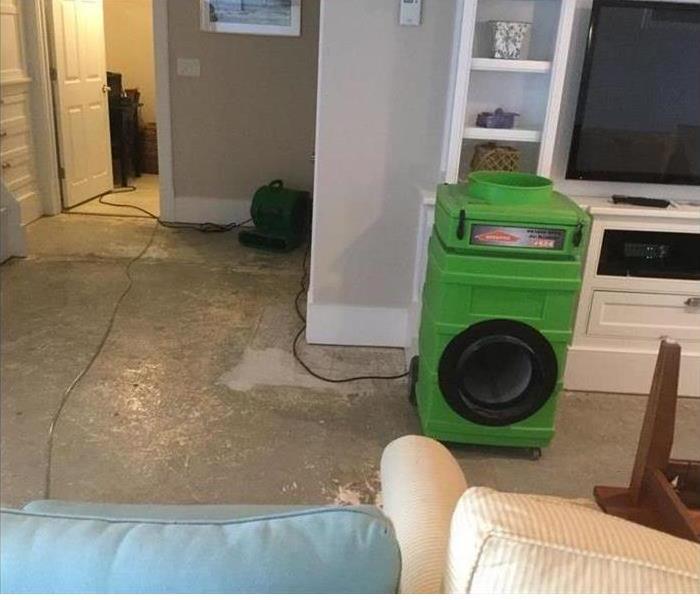 We have the state of the art equipment necessary to extract the water quickly to mitigate the water damage in your home after a flood.
We have the state of the art equipment necessary to extract the water quickly to mitigate the water damage in your home after a flood.
Storm Debris Cleanup and Water Removal in Falmouth Homes
After a flood, your Falmouth home might not even look the same as it used to. Invading water can bring untold debris and threats into the property, and these are conditions that you must recognize. It is crucial that if you are one of the first people to re-enter your home after a flood that you do so cautiously. You are looking for several potential hazards, including shock threats, structural weaknesses, holes, and dangerous debris like broken glass or contaminants.
Post-storm debris cleanup is regularly the first step in the restoration of flood damage to Falmouth homes. Our SERVPRO professionals can also utilize this time when we first begin working on your property to remove standing water to better protect your house from requiring more elaborate controlled demolition. In certain situations, our technicians must shovel out sediment, mud, and other solids deposited on the floors of the affected areas of your house. Dry and wet vacuuming can also help to remove smaller bits of debris that are not as easily removed with shoveling and sweeping.
In many situations, we cannot begin full debris removal and cleaning of the affected areas because our SERVPRO technicians must first contend with standing water. Flood damage scenarios can allow for several feet of standing water in the most directly damaged areas of the house. Because the presence of solids is expected in this water, we can utilize stronger options with larger intake hoses like our gas-powered trash pumps.
Once we have dropped the water level to no more than two inches, devices like our wet vacuums can become useful both for the present debris and for removing the remaining surface water.
Flooding can become a devastating situation for many homeowners, and this can begin with the widespread threats that can enter the property with debris and contaminants. Our SERVPRO of Upper Cape Cod and The Islands team have effective removal strategies and disinfection techniques that can manage these situations and make flood losses “Like it never even happened.” Give us a call anytime at (508) 888-5985.
See more about Falmouth.
SERVPRO Can Restore Nor'easter Storm Damage in Falmouth
10/23/2019 (Permalink)
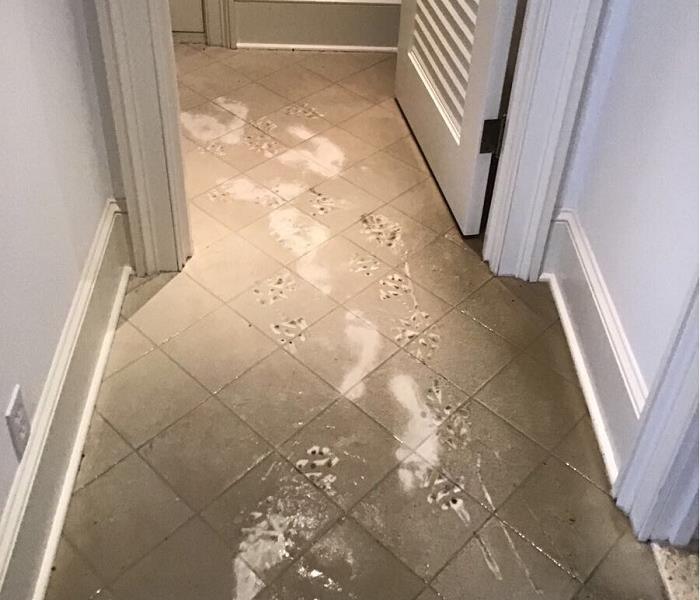 Nor'easter Storms frequently cause water damage. We have the experience, training, and are always available to restore your home.
Nor'easter Storms frequently cause water damage. We have the experience, training, and are always available to restore your home.
Restoring a Falmouth Basement After Nor'easter Storms & Flooding
Northeastern storms, which generally occur between September and April, can cause considerable storm damage and flooding. Not only are these large storms slow-moving, but their trajectories can be difficult to predict. Homeowners can expect gale-force winds, snow, rain, or potential floods that can cause considerable amounts of damage over several days.
If you need fast-acting restoration services after a nor'easter floods your Falmouth home, experienced SERVPRO teams can get to work on mitigating damage within hours. Whether you need groundwater flooding removed or roof damage from storms repaired, you can count on these extensively-trained professionals to handle it with swiftness and care. SERVPRO also has a general contracting license (CS-108357), meaning you can get disaster cleanup and repairs that are compliant with local, state, and federal regulations.
Nor'easter Preparation Tips
- Stock up on non-perishables.Three days' worth of food and water is the minimum recommended amount for sitting out a nor'easter.
- Prepare your car for the storm. Fill up your tank before the storm hits and keep an emergency kit, blankets, food, and water in your vehicle.
- Have a plan for drainage. If water does get into your home, use a sump pump with auxiliary power sources available to drain water out of affected areas.
- Check your homeowners' insurance.Not all policies cover specific storm or flood damage claims, so go over the terms of yours carefully and update it as needed.
SERVPRO Can Restore Your Home
Storm damage can happen even with meticulous preparation. A clogged or damaged interior basement drain tile can be enough to bring copious amounts of water into your home. SERVPRO technicians can salvage your basement with industrial-grade, truck-mounted pumps with their generators so that you can get relief even during a power outage.
Experts can use back-mounted extractors to remove moisture from interior nooks and crannies before the drying process begins. Depending on the extent of the damage, drying a basement with concrete floors can take several days. SERVPRO technicians emphasize disinfection, safely meeting drying goals and the prevention of mold growth and structural damage.
SERVPRO of Upper Cape Cod and The Islands is Faster to Any Size Disaster so that homeowners can have their residences restored to a preloss condition. If you need emergency cleanup after a storm, call (508) 888-5985 today.
More about Falmouth.
Things to Avoid after Flood Damage in Your Falmouth Property
10/8/2019 (Permalink)
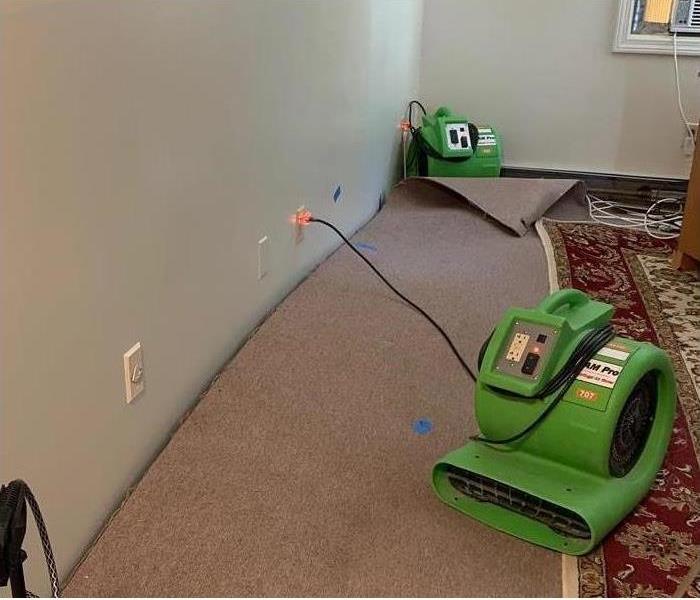 Let SERVPRO show you things to do and don’t when it comes to your Falmouth flood damaged property.
Let SERVPRO show you things to do and don’t when it comes to your Falmouth flood damaged property.
We keep up with what needs to be done for your flood damage in your Falmouth home.
When there is a flooding incident that damages your Falmouth property, you might want to take every possible action to save your property. Such quick response helps in many ways, including preventing secondary damages. Knowing what to do and what to avoid can help you address the flooding problem exhaustively. If you involve a professional like SERVPRO right from the start, you can ease the process because of the resources we avail.
Do Not Let Water Sit in Your Property Long
Most of the harm from flood damage in your Falmouth property trace back to water exposure since it has adverse effects on almost every material including metal, wood, and fabrics, among others. You should not let water sit in your property over extended periods, especially if the flood has receded outside your structure. Our SERVPRO technicians provide different types of pumps, including submersible ones and self-priming trash pumps to remove water from your structure fast. We also use procedures such as making flood cuts or even punching weep holes to help removal.
Do Not Let Electronics Cool to the Dew Point
Flooding can cause malfunctions in electronics and appliances. While you may expect direct water exposure to water to cause damages, even items that remain unreached by the water can still malfunction due to excessive humidity in the air. When temperatures reach the dew point, moisture in the air condenses. You should not let electronics cool to the dew point to protect their interior components from rusting. Because turning off the power is one of the steps taken immediately after flooding, SERVPRO technicians help by providing alternative sources of heat such as using portable heaters.
Do Not Save Porous Materials Affected By Flooding
In your home, there are many porous materials, including gypsum-based wall panels, fabric materials such as carpets and upholstery. While the items made from these materials might be highly valuable to you, trying to save them can expose your family to contaminants in the future. Controlled demolition helps remove all porous materials affected directly by the floodwater.
The correct response is crucial when trying to save your Sandwich, Bourne, and Nantucket property from flooding. Call SERVPRO of Upper Cape Cod and The Islands at (508) 888-5985 to help you. We're Faster To Any Size Disaster.
To learn more about Falmouth property, click here.
What To Except After A Flood In Your Sandwich Home
8/13/2019 (Permalink)
 Contact SERVPRO of Upper Cape Cod and The Islands at (508) 888-5985.
Contact SERVPRO of Upper Cape Cod and The Islands at (508) 888-5985.
Two Flood Damage Scenarios Faced By Sandwich Homeowners
Properties can become flooded in gallons of water in as little as a few hours. These situations can either occur from external factors such as flash flooding or internal issues like malfunctioning drains or burst pipes. The resulting situation, a homeowner, being ankle-deep in standing water, is the same. Circumstances involving flooding require immediate action to control losses and restore your property to its normal condition.
Professional services can make sure that flood damage in your Sandwich home does not cause long-term issues with odor, microbial growth, or structural impact. As a homeowner, making contact with SERVPRO to organize a restoration service is essential to the significant loss recovery procedure. External flooding issues should be left alone, as these situations can be Biohazardous waste scenarios due to contaminated groundwater.
Issues with burst pipes are often clean water emergencies allowing a homeowner to carefully remove light furnishings from the affected area and onto the upper levels of the home. This procedure can help to preserve possessions while an experienced water restoration technician is on the way. However, water exerts extreme pressure on floors, walls, and cavities in the home, if you have doubts about the structural integrity of your property, wait for a professional.
Water incidents are time-sensitive, meaning that the longer the situation continues the more damage it causes. SERVPRO technicians can deploy gas pumps to quickly remove standing water from the affected area and deposit it into a nearby sewer point. Once the water is removed, we can begin an inspection of items. In some cases, items can be cleaned on-site, others may need to be taken to an external cleaning facility and some, unfortunately, may need to be discarded. SERVPRO technicians do seek to restore items rather than replace them for the benefit of the homeowner.
In cleaning possessions, your technician can conduct initial tests on a small area to make sure that the item responds well to the cleaning solution and that no further damage is caused. Large furniture can be vacuum dried using water extractors or ventilation systems like box fans. Some fabrics may benefit from mechanical cleaning using Esporta washing machines. As your technician inspects the area, each item is earmarked and given an individual strategy for restoration. By keeping control of the small details, SERVPRO can have a significant impact on your home restoration.
Take back control of painful property damage by arranging a callout with our flood recovery team. Contact SERVPRO of Upper Cape Cod and The Islands at (508) 888-5985.
For more about Sandwich click here.
Protecting Your Roof During a Hurricane
4/18/2019 (Permalink)
Protecting Your Roof During a Hurricane
Protect your roof. Consider hurricane straps to ensure your roof is bolted to the rest of your house. And inspect your roof tiles or shingles to make sure they are secure. Use roofing cement to fix any loose tiles to prevent them from becoming lethal projectiles during a storm and damaging the underlying roofing material. Seal any areas where wires enter the home, minimizing the chance of water damage during heavy wind and rain.
Trim your trees. Broken limbs could land on your (or your neighbor’s) roof/house or become missiles that can break windows during a storm. If your tree damages your house or a neighbor’s house, your insurance cover the damages, but it may pay only a portion.
If your home is damaged during a Cape Cod area storm, call the professionals at SERVPRO of Upper Cape Cod and the Islands. Faster to Any Disaster
Source: kiplinger.com
Securing Your Home for Hurricanes
4/4/2019 (Permalink)
Securing Your Home for Hurricanes
Brace your garage door to prevent more-extensive damage. Most garage doors are not reinforced, and when the wind gets into the garage, it creates a positive push at the same time that the wind swirling above the structure creates a negative pull. That push-pull combination can cause the roof to fly off. Find a kit that you can buy at home-improvement stores to brace your garage doors.
Secure your windows and doors. Broken windows can let in wind and rain, and they can also increase the pressure under the roof. Storm shutters provide the best protection, but boarding up windows when a storm is on the way can help, too. Make sure doors have several locking mechanisms so they don’t fly open; deadbolts are best. And it’s important to secure windows and doors at all sides of the home -- not just the one facing the body of water where hurricanes could form -- because hurricanes can swirl in any direction.
Source: kiplinger
What Secondary Damage can occur after Storm Damage?
11/5/2018 (Permalink)
What Secondary Damage can occur after Storm Damage?
After roof leaks or flood damage, if not properly dried and treated, a home or business can develop mold from the moisture left on: wood, tile, carpeting, windows, concrete, and/or other materials/items that were affected. SERVPRO of Upper Cape Cod and the Islands strives to prevent secondary damage every time we remediate water damage. Building material and flooring are dried and treated to prevent mold and other allergens/contaminates using specialized equipment and cleaning products.
If water damage is not properly treated, the perfect environment is created for mold spores to grow in your home and to contaminate the air that is breathed.
Should you ever suffer water damage due to: excessive rain, storm damage, leaky roof, flood damage, a water heater leak, sink overflow, fire, refrigerator leak, or any other reason water has invaded your home or business, please know that SERVPRO of Upper Cape Cod and the Islands is here to help. Faster to Any Disaster
Types of Contaminated Water after a Storm
9/18/2018 (Permalink)
Types of Contaminated Water after a Storm
Should you experience a flood in your home after a storm, our team of technicians will inspect your home or business to determine the appropriate plan of action for the type of water encountered.
Category 3: "Black Water"
Category 3 water is grossly contaminated and could cause severe illness or death if ingested and any contact should be avoided. Examples include flooding from rivers or streams, water from beyond the toilet trap, water from the toilet bowl with feces, or standing water that has begun to support microbial growth.
- May contain untreated sewage, harsh chemicals, and microbes
- Water from flooding rivers or sewer backup
24 Hour Emergency Service
Water contaminated with sewage backup should be considered an emergency situation and dealt with as quickly as possible. Our technicians at SERVPRO® of Upper Cape Cod and the Islands are available 24 hours a day, 365 days a year for any emergency situations that arise. We have been a trusted name in safely and properly restoring homes and businesses for almost 15 years! We are here to help!
One Year After Hurricane Harvey
8/15/2018 (Permalink)
One Year After Hurricane Harvey
August 25th marks the one year anniversary of Hurricane Harvey, the category 4 hurricane that deeply affected the state of Texas one year ago. Hurricane Harvey dumped more than 50 inches of rain in parts of the Houston area, flooding thousands of homes and killing more than 80 people. The devastation was swift, and the recovery is far from over. SERVPRO® franchises from all over the country were proud to come to the aid of the people whose homes were damaged by the hurricane. The water damage was catastrophic. The professionals at SERVPRO® worked especially hard during that hurricane and will always be here for you during any New England storm or Nor'easter...faster to any disaster to help you through any type home flood.
Lightning During Storms and House Fires Resulting
8/15/2018 (Permalink)
Lightning During Storms and House Fires Resulting
Unlike other types of house fires, which occur more frequently in the winter months, fires in the home caused by lightning are more likely to happen in June, July and August in the late afternoon or early evening. From 2007-2011, NFPA says there were an average of 22,600 fires per year caused by lightning strikes. Lightning is responsible for a number of wildfires as well.
Lightning during storms poses the greatest risk outdoors and frequently strikes the highest point on a structure.
Safety tips During Lightning Storms:
- When possible, stay away from doors and windows during an electrical storm.
- Do not use corded phones, computers, TVs or other electrical equipment during storms.
- Unplug major electronics – TVs, stereo equipment, computers and microwaves to minimize damage if there is a lightning strike close by.
- Avoid plumbing such as sinks, baths and faucets during a thunderstorm as metal plumbing is an excellent conductor of electricity.
Source: http://www.propertycasualty360.com and National Fire Protection Association
5 Guiding Steps for Mold Remediation after a Storm
4/19/2018 (Permalink)
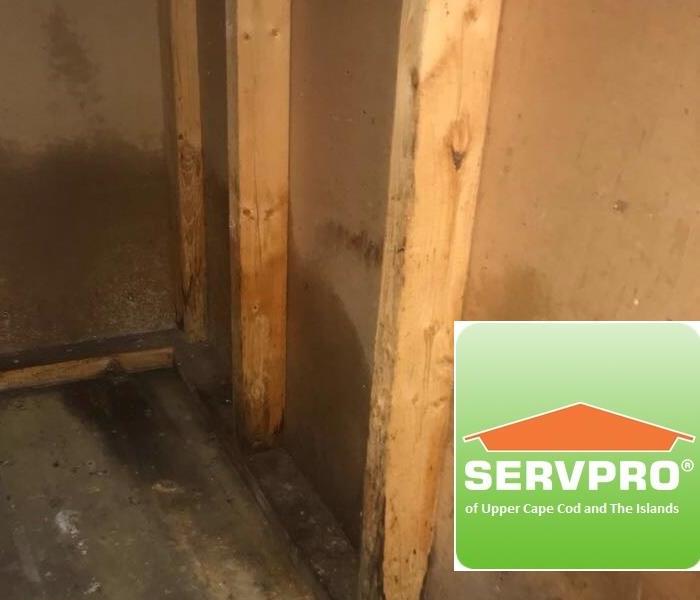 SERVPRO of Upper Cape Cod & the Islands is a leader in the storm damage remediation industry. They offer exceptional water & mold damage restoration.
SERVPRO of Upper Cape Cod & the Islands is a leader in the storm damage remediation industry. They offer exceptional water & mold damage restoration.
We know the storms this winter did a lot of damage in our area with widespread flooding and falling trees. It’s during these times when water damage from a storm can leave you exposed to having a mold problem if not cleaned up immediately or professionally. Mold is a fungus that grows in areas that have moisture. Its development in the different areas of the house or office gives off an unpleasant odor coupled with an unaesthetic view. It is an awful sight to look at. It grows in filaments and spreads if left unchecked. The bathrooms, walls, ceilings, kitchen cabinets and wardrobes are a few of the significant spaces that get affected by mold. Recently the towns of Cape Cod, Nantucket, and Martha’s Vineyard were affected by nor’easter storm Skylar, Riley and Cyclone Bomb. Their adverse effects were due to strong winds, snow, and flooding. As we are well aware of the fact that water is one of the important constituents in that help in boosting growth since it creates moisture if left untouched at a space. Read ahead to know how to go about remediation at your property after a storm.
Look at the following five steps that should be followed for basic and quick restoration:
Evaluate Moisture
Assessing spore growth involves more than just looking at what's clearly and visibly growing on the walls or in a corner. First, understand that the reason behind all unwanted spore growth is water and moisture. The ultimate goal is to identify the moisture source and use its location to help locate all mold growth.
Remediation Plan
Before we start the remediation process, it is best to document the situation with photos which is standard with our service. This will be useful for the restoration team and will also help the claim manager from the insurance company to help determine coverage. It will assist in developing a remediation plan, which typically answers questions like work beginning time, work completion time, performing the remediation, any testing that should be done, and will homeowners be temporarily relocated – all things are noted down in this document.
Extent of the Contamination
Mold growth is usually never restricted to one specific area. Hence, you need to calculate the extent of the contamination. This will decide how you approach its removal and clean up. The goal of remediation is to clean up the growth within the home and to avoid exposing residents to large amounts of it.
Mold Remediation
Remediation involves cleaning up existing mold with minimized exposure to one’s self as well as loved ones. The procedure will also prevent new growth by addressing the moisture source based on the calculations of the contamination area. This step is further divided into steps to have an effective approach. Things to be done are:
- Repairing water problem
- Isolation of contaminated area
- Removing soggy materials
- Discarding damaged, affected and wet materials in plastic bags
- Cleaning of porous and wood surfaces that have been affected
- Cleaning all areas along with egress
- Proper inspection, just to be sure
- Drying of the materials
- Repairing or replacement of materials
Determining Successful Cleanup
In the end, we have to be sure that our clean-up efforts after water damage remediation have been successful. It is similar to a judgment call after all the procedure. According to EPA guidelines, look for the following:
- Verification of moisture problem by revisiting the home soon after remediation and you shouldn't see any signs of recurring water damage
- Checking for no sign of visible mold, materials damaged by it or any odors that may be there in its presence
- Residents should be able to occupy or re-occupy the home without aggravated health complaints
- Depending on your company and the details of the problem, additional testing by an environmental testing company may be considered after the cleanup to be sure enough.
Storm damage brings problems and mold is one of them. It occurs due to flooding, leakages or blockages in the pipes. Hence, it is better to be attentive to the timely inspection of the pipes before the storm. If you’re facing a mold problem, it will be better to call in professionals from a competent restoration company for effective removal of mold.
Call us now at (508) 888-5985.
Effective Ways to Prepare for and Minimalize Storm Damage
4/5/2018 (Permalink)
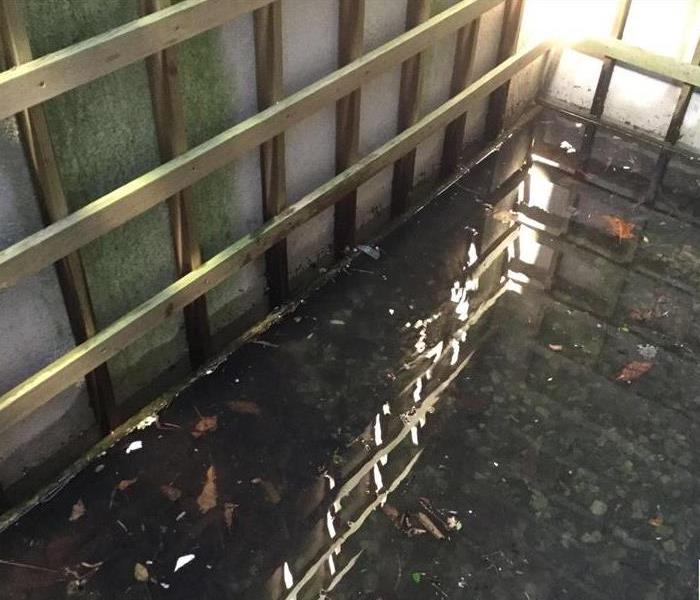 SERVPRO of Upper Cape Cod and the Islands is a team of dedicated storm damage cleanup crew which ensure the best quality restoration and remediation.
SERVPRO of Upper Cape Cod and the Islands is a team of dedicated storm damage cleanup crew which ensure the best quality restoration and remediation.
Natural calamity is unpredictable and waits for none. It varies in nature and can arrive in form of strong winds or sometimes followed by a flood which further adds difficulties leading to a largescale disaster. Recently the storm effected many different towns on Cape Cod, Nantucket, and Martha’s Vineyard that left considerable damage to homes and businesses. The residents on the East Coast had their lives turned upside down when heavy rains, gusting winds, and snow pummeled States due to the winter storm Skylar which was the third Nor’easter in two weeks. In addition to this, Cyclone Bomb has brought floods and tidal surges into the region. According to reports, six people died when fierce winds brought trees crashing down on roads, homes and surrounding buildings.
These natural events are inevitable. One should always be prepared for the worst and utilize ways to minimize the damage. Due to storms, not only is the property damaged but if it gets flooded, it can also lead to mold growth on visible as well as hidden areas. In such a case, if water damage is left untreated, it can increase the problems you will have to face in that scenario.
Read ahead to know about some of the points that need to be considered in order to reduce the damage:
Reducing Storm Damages
- First of all, ensure that all drains and gutters are clear of debris to prevent blockages which can lead to more flooding in house if left as is. If the growth progresses, you will have to get professional mold remediation done to keep your house or office fit for health.
- If it is safe to carry out, check if your pipes and water tanks are insulated to prevent freezing. Secondly, ensure that the release point of overflow pipes is not obstructed. Ideally, you'll have a regular maintenance program in place to keep everything in order.
- Cut back trees and branches to minimize the risk of broken branches that may fall or are move by the strong storm winds.
- Secure loose fences so that these remain intact and grounded. The best option is to remove them completely to avoid any unseen problems for the duration of the storm(s).
- Check that all roof shingles, tiles and aerials are secure. It may be worth seeking professional advice, if needed, to make things better.
- Make sure all garden furniture, ladders, decorations, etc. are secured and locked away in the shed or inside the house to avoid dispersion from strong winds.
- As soon as you get official warnings about gale-force winds and floods from the concerned authorities, make sure your children, pet, family, loved ones and neighbors are safe. Ensure that they stay at home and wait it out. If the danger level is higher, evacuate as per official guidelines. Please do not try to repair damage during the storm.
- It is recommended to maintain a minimum temperature of 55 degrees in the home during severe weather, in particular, to protect pipes from freezing.
- Last but not the least, if you have home insurance, take a look to know what will be covered in the event of your property being damaged by storm.
Mold Remediation
Mold growth can arise as an aftermath of the storm. During the storm, the pipes, down-spouts or gutters may get blocked, freeze due to winter winds, or cause leakage from roofs and walls after heavy storm rains. Moisture and stagnancy, if left unattended, will trigger mold growth. It is better to inspect the house soon after the storm to assess the damage. If the affected area is large, call in professionals to do the job with specialized equipment and procedures.
For more information on storm damage, water cleanup and mold remediation, call us at (508) 888-5985.
12 Types of Storms
11/10/2017 (Permalink)
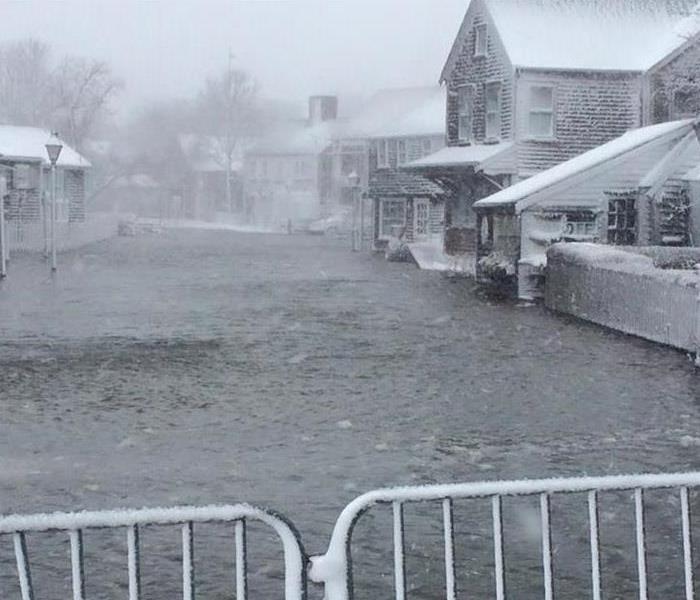 SERVPRO of Upper Cape Cod and the Islands is competent storm damage restoration service that will help you restore your property
SERVPRO of Upper Cape Cod and the Islands is competent storm damage restoration service that will help you restore your property
Don't like the weather on Cape Cod? Wait a minute, it's sure to change!
Being a part of the Cape Cod community, SERVPRO of Upper Cape Cod and the Islands understands the needs and requirements of the locals when it comes to storm damage. Not only are we proactive in our approach towards disaster remediation, but we also ensure that our clients get the best restoration services available. Storms come in all sizes, shapes, and forms, and we understand that our region is prone to seasonal storms of many types. From tropical storms to hurricanes, the Cape Cod residents have braved through it all, and we have always been there to help them get their property back to "Like it never even happened."
Here, we are highlighting the most common types of storms that are prevalent in the Cape Cod, Massachusetts:
Hailstorms
With strong and heavy winds, hail storms can range from moderate to severe type. Based on the size and shape of the ice pellets and hailstones, it can cause minimum to high damage to your property. The size of the pellets can range between 0.2 to 0.5 centimeters in diameter.
Ice Storms
Similar to hail storms, ice storms are also pushed by heavy and strong winds. Instead of carrying hailstones and ice pellets, the ice storm usually brings rain. Due to freezing temperatures, the rain freezes upon falling on the ground or on impact. Ice storms can weaken wooden structures, poles, buildings as these can be responsible for ripping apart grown trees due to the accumulation of weight on the branches.
Snowstorms
When the temperature falls lower than zero, the strong winds spread snowflakes. This kind of storm is called a snow storm. If the storm is prolonged for hours or overnight, it can easily form inches of snow cover. On the weak areas of your property, this accumulation can cause stress and even breakage.
Blizzards
When a snowstorm worsens, it ends up becoming a blizzard. These will have stronger winds of around and over 35 miles per hour. Another indication of blizzards is that these will continue on for hours. The wind damage can become devastating for weaker and standalone structures. The snow that gathers in the storm will impact roofs, windows, etc.
Thunderstorms
When the skies turn dark due to heavy clouds and are accompanied by highly frequent lightning, then it is called a thunderstorm. Moderate to heavy rain may also fall during the thunderstorm, but not always. The severity of winds is relatively low. If the lightning strikes on your property, it will lead to heavy damages and may even cause a fire incident.
Rainstorms
The only difference between a thunderstorm and a rainstorm is that is the former has more concentration of lightning whereas the latter brings with it heavy rainfall. Rainstorms may cause flash flooding which can heavily damage property, especially basements. Water damage and mold remediation will be necessary afterward. The tropical storms are prone to hit the Cape Cod region every five to six years, according to meteorologists.
Windstorms
These storms are composed of very strong and heavy winds which may or may not include rain. However, due to the intensity of the winds, windstorms are accompanied with stones, dust, and even hailstones. This storm is strong enough to uproot trees and cause damage to property, especially the exteriors.
Dust Storms
These storms carry sand particles and dust. The overcast will have a yellowish tint. Such a storm makes breathing and visibility difficult. The damage may not be as heavy as other storms but it can result in accumulation of dust particles in vents and even within houses and offices.
Sandstorm
The content of sandstorms differs from dust storms in the sense that it carries majorly sand. These storms are more common in and around desert areas where the winds carry off a huge amount of sand. When faced with a sandstorm, the property may be damaged moderately to a medium level of intensity.
Cyclones
These are the most severe types of storms that rotate in anti-clockwise or clockwise direction. As these travel, they rip off whatever comes in their way. The destruction level is intense and precautions need to be taken beforehand to avoid damage.
Hurricanes
This is a severe cyclone which has its origin near the equator. It travels north and hence moves counterclockwise. A hurricane is accompanied by heavy rains and violent winds. It destroys everything in its path. Cape Cod suffers the Atlantic hurricane season almost every other year which may or may not affect the region. Meteorologists state that Cape Cod is hit by a violent hurricane every eleven to twelve years.
Tornadoes
This storm is basically a fast whirling wind which rotates clockwise and builds up due to wind pressure. The dust on the ground is forced into the swirl of the tornado. As it passes over urban areas, it rips off the property if the intensity is strong. The tornadoes that hit oceans are called water sprouts.
For any and all storm damage restoration, you can call SERVPRO of Upper Cape Cod and the Islands at (508) 888-5985.
Hurricane Season in Full Force for Cape Cod & the Islands
9/19/2017 (Permalink)
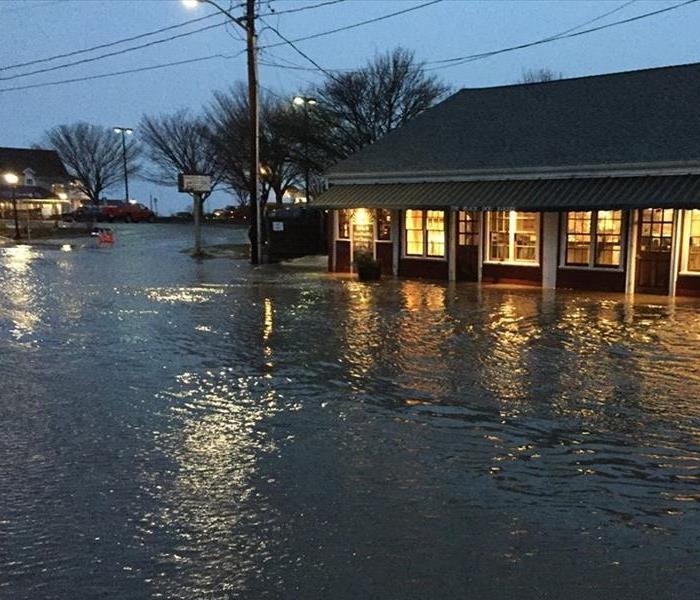 SERVPRO Ready as East Coast Prepares for Jose's Arrival.
SERVPRO Ready as East Coast Prepares for Jose's Arrival.
After the recent catastrophic devastation at the hands of Hurricane Irma, the Caribbean and the East Coast prepare once again. This time, the threat comes in the name of Hurricane Jose which is swirling its way up slowly. Being the third major hurricane of the year, it is reported by officials to hit coastal areas from Virginia up towards New England. The outer Cape Cod and Boston areas have been issued a hurricane warning. SERVPRO, the leading name in water damage cleanup services is ready to face this challenge. With our 24/7 emergency service available to all in Cape Cod, we aim to minimize the damage caused in the hurricane’s wake. Our professional crew and emergency teams will help you in restoring your property to its formal glory and make it "Like it never even happened."
Here are few things for you to keep in mind regarding Jose and the probable damage it may cause:
A Little About Hurricane Jose
As of 8 am, Tuesday, September 19, 2017, latest update on Hurricane Jose and Hurricane Maria is that tropical storm watches have been issued for areas including Delaware up towards Cape Cod. The National Hurricane Center has stated that Hurricane Jose is “expected to cause direct impacts from Delaware northward to New England.” Jose will have an offshore track but it is predicted that its tropical-storm-force winds will go beyond the conventional center of circulation. It has sustained wind speed of 65 knots (75 mph; 120 km/h). Due to Jose, areas up till New York will see big wave action and erosion. An official Tropical Storm Warning has been issued in Cape Cod, especially Nantucket and Martha’s Vineyard.
DIY Tips before the Storm Hits
First and foremost, communicate with your local authorities to ensure if there has been an evacuation warning. If you are allowed to stay within your homes, then there are quite a few DIY steps that you can manage on your own to minimize the storm damage. Ensure that you have a well-stocked Emergency Kit which includes first-aid kit, food, clothes, emergency items and such. Rehearse evacuation routes with your family members to make sure everyone knows what to do and where to gather. Apart from these, if it is safe for you stay indoors while the storm passes, ensure that you have all windows, doors and vents checked properly. Leave nothing in your lawns and backyards that may fly and damage the windows or exterior. You can contact us for further instructions on how to minimize the storm damage on your property.
SERVPRO Against Hurricane Jose
We are a locally owned company which harbors national storm resources. Since we are from the community and work for the community, we understand the need for restoration efforts that are necessary after a catastrophic disaster. Our company is based in the Upper Cape Cod and the Islands. Hence, we are ready to respond to any emergency call at any time. We pride in being active members of our community. As a reputable water removal service in Cape Cod, SERVPRO always steps up to play its part for the community.
24/7 Emergency Service Available
When dealing with hurricanes, blizzards, floods, tornadoes and the likes, we utilize our vast network of storm teams which are strategically placed. These teams are always on standby to help you in the unfortunate case where your locality gets hit by such a calamity. We have more than 1,700 franchises spread across the nation. As soon as an area is hit, we pool in the resources from our network to focus on local command centers. Their expertise are available for you all through the year. We consider no disaster to be too big as we handle residential and commercial projects of all sizes. The Catastrophic Storm Response Team has handled major disasters in the past such as Katrina, Sandy, Polar Vortex and Chicago floods among others.
We hope, pray and advise that everyone stays safe!
If you have further questions about Water Removal and Storm Damage Restoration in Cape Cod, feel free to contact us anytime at (508) 888-5985.
Some Cape Cod & Islands Property Owners Left Dealing with Water Damage from Arctic Blast
2/18/2016 (Permalink)
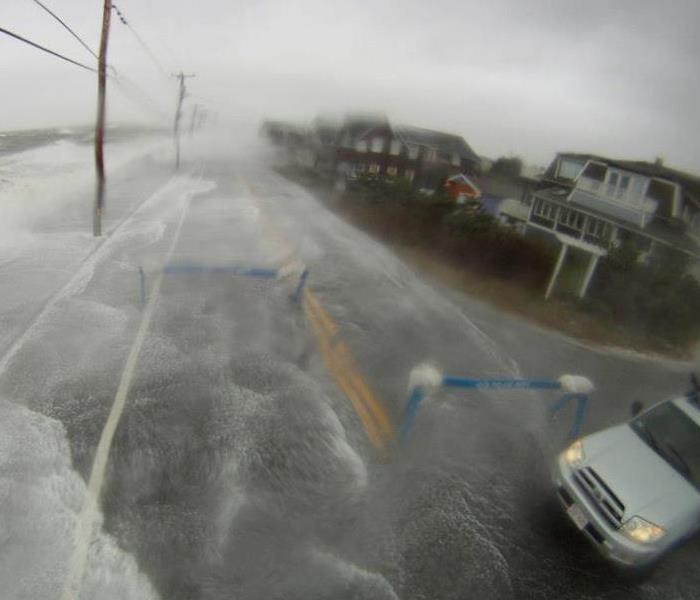 If you or someone you know is experiencing a water damage from frozen pipes call us for service at 508-888-5985.
If you or someone you know is experiencing a water damage from frozen pipes call us for service at 508-888-5985.
The Arctic Blast that came in last weekend is now a distant memory for many. However, for some the effects have just begun. At SERVPRO of Upper Cape Cod & The Islands we've been experiencing a higher volume of calls from both residential and commercial property owners who are now experiencing broken pipes and water damages across Cape Cod & The Islands now that temperatures have returned to above normal across the region.
Here is some information for those dealing with water damage on Cape Cod & The Islands
Some other things you should consider when hiring a company to help you recover from storm damage here on Cape Cod & the Islands
- When contracting a cleanup and restoration company that can help you restore your property, "Like it never even happened." make sure they have the correct insurance to be doing this type of work.
- If you need to hire someone to do the reconstruction make sure they hold a General Contractors License and are fully insured with both liability and worker's compensation. Note: Anyone that works on your property should carry their own WC Policy or any accidents that may occur will be covered under the property owners policy.
- Make sure a building permit is acquired and all inspections are passed before final payment is issued. And remember to report any upgrades or changes to your property to your insurance agent or carrier so they can add it to your policy. Note: Upgrades to kitchens and bathrooms or even flooring should be noted in your policy for future coverage.
Going through a water damage is hard enough but not having the right resources and information to guide your decision making can sometime add unneeded stress to an already stressful situation. At SERVPRO of Upper Cape Cod & The Islands we want to help you recover from a water damage as quickly and effortlessly as possible. Call 508-888-5985 for help 24/7!
Here are some other helpful resources:
A list of local insurance agents and carriers
Six Steps to a Water Damage Clean up & Repair
Institute of Inspection Cleaning and Restoration Certification
Fall Back is a Good Time to Catch Up on Storm Preparations on the Cape Cod & The Islands
10/25/2015 (Permalink)
 Use your time wisely to help you and your family prepare for potential storm damage.
Use your time wisely to help you and your family prepare for potential storm damage.
This weekend marks the end of daylight savings time which means it’s time to fall back…giving us an extra hour on Sunday….an hour that could be used to prepare for any storms that might blow our way in the coming months.
I’m not sure about you, but I could use an extra hour in every day! I remember one year when daylight savings time ended, but my husband Bill and I failed to take advantage of the extra hour to sleep in. Oblivious to the fact that it was one hour earlier than the clocks in our house and cars indicated (yes, folks, this was the era before iPhones and smart phones that readjust the clocks for us), we got our three children up on Sunday morning, fed them breakfast, got them dressed, and loaded them into the car. We headed out to get a few errands done, which included some shopping. Thinking that it was well passed the scheduled noon opening time, we were stunned to find one store after another still closed. Confused and perplexed, we looked at one another until it finally dawned on us—everyone else in the state and the country remembered to turn their clocks back except for us.
As much as I celebrate gaining an hour, I also grieve it a bit, too, knowing that the sunsets will occur earlier, making the days feel shorter. There is something sad about driving home from work in the dark. It signifies that the winter season—and the cold weather and the storms that go with it—really is just around the corner.
Since we do get an extra hour on the first Sunday morning when daylight savings time ends, the best use of this bonus time might be spent preparing for the upcoming winter season and checking on a few things. For instance, this is a great reminder to check the batteries in the smoke and carbon monoxide detectors. It’s a good time to seal up any cracks around windows and doors to ensure that there are no cold drafts pouring into the home, driving up our heating bills. This is also a good time to schedule an annual maintenance of your furnace. This not only helps to prevent a “puff back,” which can blow soot all over your home and belongings, it also helps to ensure that the furnace is working efficiently, which helps keep the heating bills in check.
If you have a storm emergency kit, this is the time to check it to make sure that it is fully stocked with things like flashlights, candles, batteries, water, non-perishable foods, etc. If you don’t have a storm emergency kit, then this certainly is a good time to put one together.
Daylight savings should serve as a reminder to have your chimney cleaned, since a build up of creosote can cause a chimney fire.
This is also a good time to clean up exterior spaces—making sure that any outdoor furniture is stored away and any items that remain outside are properly covered.
Since daylight savings 2015 officially ends on November 1 this year, after the last of the trick or treaters have come and gone, go ahead and turn back the clocks in your house and take pleasure in knowing that you can enjoy an extra hour of sleep the next day. And if you happen to forget about the time change, fear not…your phone will let you know.
Winter Storm Damage...Cape Cod & The Islands Are We Ready for 2016?
10/19/2015 (Permalink)
 Don’t get caught without an emergency response profile to help with winter storm damage.
Don’t get caught without an emergency response profile to help with winter storm damage.
Winter storm damage never happens at a convenient time. Storms can range from a blissful snowfall to an extreme storm and we learned that the hard way during the winter season of 2015.
Many winter storms are accompanied by dangerously low temperatures and sometimes by strong winds, icing, sleet and freezing rain. If a big storm is coming be prepared…fill your required prescriptions, gas tanks and your pockets with cash.
Seriously, baby its cold outside and that’s why it’s important for families to get ready now. Before we know it winter will be here and we should take the time to create an emergency plan that includes enough food, water and supplies to last at least three days.
The biggest concern is that the electricity can be out for days as experienced during the winter season of 2014. Many areas did not have power for up to five days. And lastly, communication. How will you learn about what is going on in your community, where you can go for help or shelter or to learn what the plan is for the local authorities to help the community to recover? If there is no power you won’t be able to listen to the television or radio and the battery in your cell phone will not be able to be charged! Having a plan in place puts you in the driver’s seat!
Before winter storm damage happens gather basic items that would be needed if you were house bound during a bad storm.
- One gallon of drinking water per person
- Non-perishable food (Canned, dried, nuts & protein bars)
- First aid kit
- Prescriptions and medications
- Toothbrush and toothpaste
- Feminine hygiene supplies
- Garbage bags
- Flashlights and batteries
- Hand Sanitizer in liquid form and towelette
- Blankets and Sleeping bags
- Matches
- Firewood
- Propane gas for grills
- Rock salt and Sand
- Shovels or snow Removal Equipment
- Candles
- Warm clothing
During the winter storm damage you should stay indoors. When you do venture outside be careful when walking on icy driveways and walkways. Avoiding overexertion when shoveling snow is key to staying safe. Overexertion can bring on a heart attack—a major cause of death in the winter. Make sure you take breaks to rest and when possible push the snow instead of lifting or lift lighter loads. You will want to keep dry and change your wet clothing frequently to prevent a loss of body heat. Did you know that wet clothing loses all of its insulating value and transmits heat rapidly?
Important signs of severe health risks during a winter storm
Signs of Frostbite: Occurs when the skin and body tissue just beneath it freezes. Loss of feeling and white or pale appearance in extremities, such as fingers, toes, earlobes, face, and the tip of the nose.
What to Do: Cover exposed skin, but do not rub the affected area in an attempt to warm it up. Seek medical help immediately.Signs of Hypothermia: Dangerously low body temperature. Uncontrollable shivering, memory loss, disorientation, incoherence, slurred speech, drowsiness, and apparent exhaustion.
What to Do: If symptoms of hypothermia are detected take the person’s temperature. If it is below 95°, seek medical attention immediately. Get the victim to a warm location. Remove wet clothing. Warm the center of the body first by wrapping the person in blankets or putting on dry clothing. Give warm, non-alcoholic beverages if the victim is conscious. Seek medical help immediately.After every winter storm restock your emergency supplies to be ready in case another storm hits.
Assess how well your supplies and family plan worked. What could you have done better?Take a few minutes to improve your family plan and supplies before the next winter storm hits.Talk to your neighbors and colleagues about their experiences and share tips with each other.
Flooding: What Happens When It Rains Here on Cape Cod & Islands
10/2/2015 (Permalink)
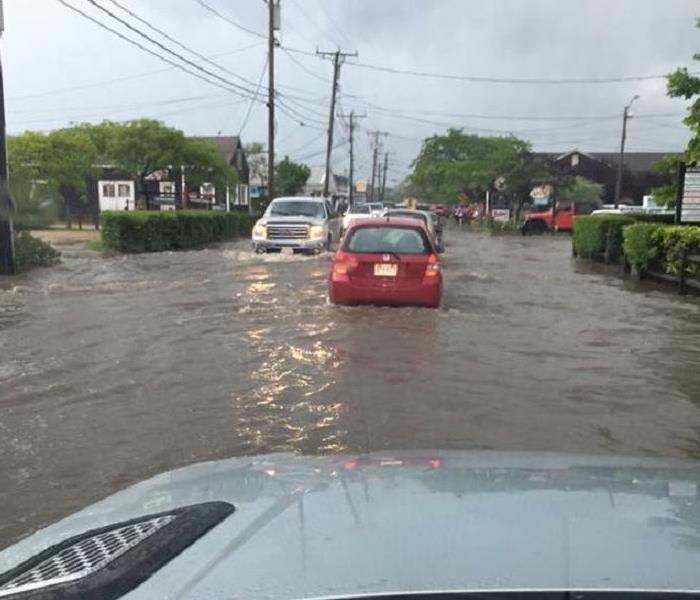 The remnants of a storm that passed over Vineyard Haven, MA 02568.
The remnants of a storm that passed over Vineyard Haven, MA 02568.
Life on this side of the bridge is vastly different from the rest of the world.
In any other part of the state, a forecast for a tropical storm or hurricane will certainly have people running for the grocery stores—and I’m still not sure how bread and milk is critical to storm survival—but when you live on the Cape and the islands, those same predictions conjure up much different anxieties.
Any fierce storms accompanied by strong winds can leave the people on this side of the bridge susceptible to becoming isolated from the rest of the world. Sustained winds of 70 miles per hour or higher will close the Bourne and Sagamore bridges, leaving Cape Codders and Islanders cut off from “civilization.” Depending on where you live and which side of the bridge you happen to be on when they are closed, that may not be a bad thing. For those living on Martha’s Vineyard or Nantucket, isolation is even more frequent and probable. When the winds blow hard enough and the seas get rough enough, the Steamship Authority makes the call where you can stay or go! For people who happen to live on one of the islands and are visiting the “mainland,” or vice versa, worry goes well beyond, “will I have milk and bread for the next 24 hours,” to “can I get home before the storm.”
I have been in situations where either I—or my crew—had to scramble to get that last ferry or plane on or off and know it is not a fun game to be played. Before you start thinking that getting stranded on either side seems more like a vacation than an inconvenience, consider that there tends to be fewer hotels and restaurants open during the winter and there are very few vacancies in the summer.
I have also found myself in the predicament where I was off Cape and needed to get to this side of the bridge before a storm hit. It is even more stressful waiting for a loved one to make it home before the possibilities of either the bridges closing or the ferries and planes shutting down.
As Hurricane Joaquin losses steam as he makes his way up the east coast, I am preparing for any remnants he might throw my way and this includes everything from making sure that my crew is ready for any calls that come in to fighting off shoppers for that last loaf of bread to making sure that I am on the right side of the bridge before the storm hits.
If you have ever been unable to make it home during a storm to the Cape and Islands or worse—stranded at the airport—tell me about it. I would love to hear your story.
Wind and Flood Damage….A Coastal Property’s Enemy on Cape Cod
10/2/2015 (Permalink)
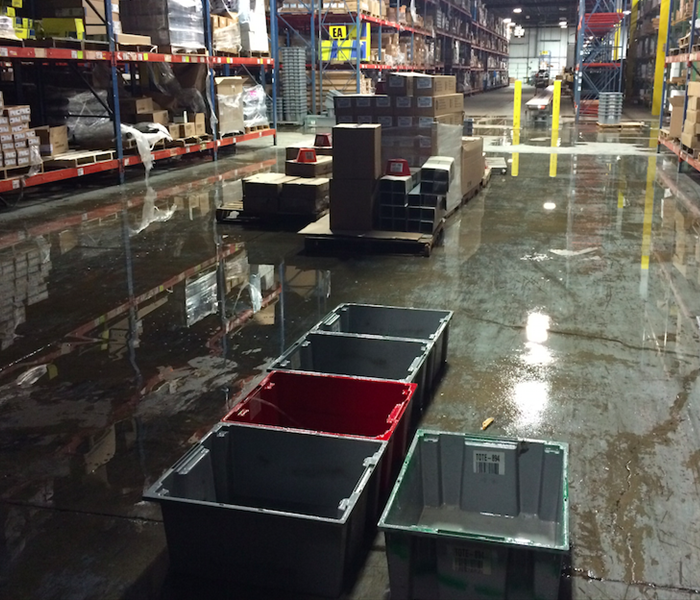 Water damage from a passing storm near Cape Cod.
Water damage from a passing storm near Cape Cod.
Nothing strikes fear into the heart of a property owner on the Cape and Islands like the words, Hurricane or Tropical Storm. Sure, we have lived through some significant storms—everyone remember Hurricane Bob?— and perhaps that is why we take it seriously when predictions about a hurricane or tropical storm begin to surface. Even if the storm doesn’t live up to the hype of weather forecasters, we know that these storms are likely going to include wind, rain, and flooding and those elements can do significant damage to coastal properties….whether those properties are located close to the water or a bit further inland. All homes and businesses are vulnerable to the damage that rain, wind, and flooding can cause but ironically many property owners are not aware of the damages that can occur, how to respond to those damages, and what is even covered under their insurance policies.
There are two types of water damage?
Yes, there are two ways that water can get into your home—from the top and from the bottom. If it infiltrates the home from the roof, usually because of faulty shingles or gutters that were not cleaned, it is definitely an inconvenience but, fortunately, it is usually covered under your insurance policy. If it enters from the basement, it is called groundwater infiltration and this type of water damage is most likely not going to be covered by your insurance policy. But make no mistake about it, the damage needs to be cleaned up as soon as possible. If the basement is unfinished, and by unfinished, I mean concrete floors and walls with no drywall, framing, insulated walls, or carpeting and the water level is low—less than an inch—you can probably handle the clean up yourself. Start by turning off the power in that area—remember electricity and water are a bad combination, so be sure you know what you are doing—then prop up any items or boxes off the floor to mitigate further damage. Hint: if any of the boxes are cardboard, replace them with plastic bins. Even if the cardboard did not get wet, the material is a source of food for mold and wet cardboard is considered mold’s Thanksgiving Day. Remove the standing water by mopping it up, pushing it out with a broom or using a sump pump. If you have fans, bring those in to circulate the air and dry out the space. Hint: If there is any evidence of mold, do not use the fans since this will spread the spores. If the water level in the unfinished basement can be measured in inches or if the basement is a finished room to any degree, you need to call in a professional. The water remediation professionals at SERVPRO of Upper Cape Cod & The Islands have the knowledge, experience, and equipment to make it, “Like it never even happened.”
Hot tip #1: If the water level can be measured in feet, you definitely need to call in a professional, immediately. When a high volume of water is pumped outside at a high rate of speed, it may cause significant structural damage.
Wind can cause a variety of damages…from sending furniture and other debris into the air, crashing into windows, to knocking trees onto roofs, to ripping shingles up from the roof. The biggest misconception that property owners have about wind damage pertains to their insurance deductible. Most property owners believe that the deductible or amount that they will have to pay is based on the cost of the damage; however the deductible is actually based on the percentage of the total value for which the home is insured.
Any damage caused by the wind should immediately be addressed. A broken window should be boarded up from the outside and any hole in the roof should be covered—from the outside!—with a tarp. Yes, we actually responded to a damage where the tarp used to protect the roof was secured from the inside and not the outside—providing a nice area for rain to collect causing the tarp to collapse inside the structure. If you are unsure of how to properly secure your home or reluctant to head up to the roof, contact the professionals at SERVPRO of Upper Cape Cod and The Islands, who can begin the process of making it, “Like it never even happened.”
Hot tip #2: Take notice of the trees around your property. If a tree’s root system does not seem sound or strong or there appears to be some erosion, consult an expert. Remove any branches that are hanging close to the roof or whose width is not relative to the height of the tree.
5 things to do before the storm arrives:
Look around the property. Anything that is unsecured, lawn furniture, toys, tables, and chairs should be brought inside or stored away. Secure the grill as much as possible.If your property is located near the water, and you have hurricane shutters, go ahead and use them, even if the storm is not categorized as a hurricane.Remove any solar-powered ground lights. Ground lights that are hard-wired can be left in the ground.Wrap burlap around ornamental trees or fragile bushes. You can also stake and string trees and bushes.Take in any window air conditioners.4 things to do…and not to do… after a damage
If water has infiltrated the basement, shut off the power. Remember, electricity and water are a deadly combination. If you have to walk through standing water to get to the circuit breaker box, consider calling your power company to come out to shut off the power. If you are unsure of the best and safest way to shut off the power, call your local fire department.To mitigate any further damage to your valuables, raise any items up off of the floor and out of the water.If the roof has incurred any damage, immediately cover it with a tarp. If a window has been broken, immediately board it up. If you are unsure of how to do this, contact a professional.Check on neighbors—especially the elderly—to make sure they are safe.
Are You Ready for a Storm?
9/25/2015 (Permalink)
You wouldn’t wait until December 24 to start preparing for Christmas, so why wait until a storm is predicted to begin preparing for that event. As someone who works well under the pressure of a deadline, I understand how attractive procrastination can be. But when it comes to the safety of my family and taking care of my property, I cannot put off until tomorrow what should be dealt with today. When you plan before a crisis, you have the benefit of clarity of thought and therefore your action plan will be complete and hopefully your emergency kit will contain a few unexpected pleasures.
According to the website, ready.gov, there are several plans to put into place now so that you can rest somewhat easy when television stations across the state preempt favorite television shows to talk about an approaching storm.
1. Have a plan in place for receiving emergency alerts and make sure all family members know where to meet in case the family is separated before or during an event. Cell phone coverage will most likely be limited so know where the closest emergency shelter is and consider making that your meeting place. Make a paper list of contact numbers and make sure all members of the family have a copy of the list. Just as an aside, don’t you miss the days when we could memorize our children’s and parents’ telephone numbers?
2. Emergency Kit. While most people know that it is important to put together an emergency kit, the majority of people do not know what items to put into the kit. After all, one person’s necessity is another person’s, “what the heck is that doing in here?” According to ready.gov, the kit should contain one gallon of water per person for at least three days, a flashlight with batteries, medications, a first aid kit, a whistle to signal for help, pliers or a wrench to turn off water or utilities, a manual can opener, and non-perishable canned goods. The kit can also contain games that the family can play or small toys and activities, depending on the age of your children. Consider including some hygiene products, such as hand sanitizer, wet cloths, and deodorant. Since you are preparing this kit well in advance of a storm, consider putting in some nice to have items, such as chocolate or other treats. Yes, you should change those items out with a fresh supply every few months.
3. Alternative Energy Solutions. If you have a backup power generator, make sure that it has been installed by a licensed electrician and has been tested. If the generator is gas powered, be sure that it is located a safe distance from the home. If you are using a fireplace or wood stove as a heat source during power loss, make sure that you have enough wood to keep warm for at least three days and that the home is properly ventilated. Check on neighbors—especially elderly neighbors—to make sure they are warm and safe. While a gas grill can be a great alternate cooking source, NEVER bring it inside the home or into garage.
4. If the power does go out, chances are gas stations will not have power either and therefore, pumps will not work. Make sure that your vehicle’s gas tank is full and that there is gas for the generator and snow blower.
September is hurricane preparedness month so take a few days to consider the items you use on a daily basis, the things your children love and that bring them comfort and make sure that as many of those items as possible are in your emergency kit. When a hurricane or severe snow storm does hit, it can be very inconvenient and uncomfortable. Being prepared for the storm can take away some of that discomfort and even make surviving a few days without power a fun memory.
5 Steps Business Owners Can Take to Prepare for a Hurricane on Cape Cod, Nantucket and Martha's Vineyard
9/25/2015 (Permalink)
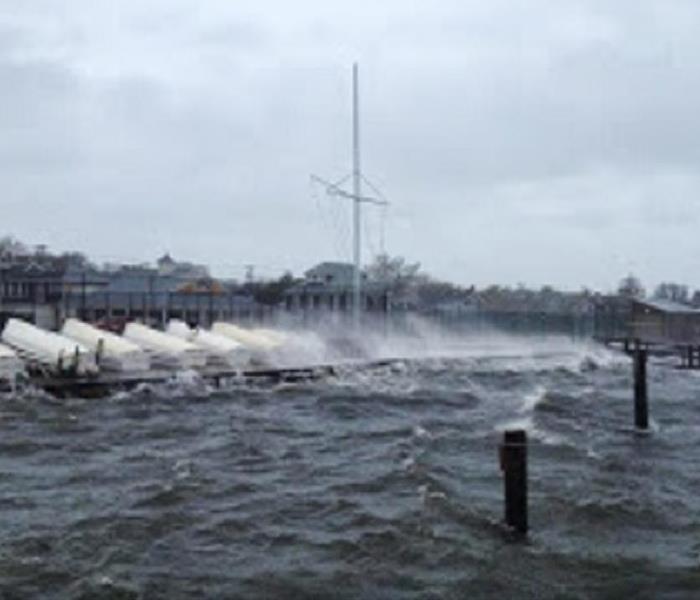 This photo is of Hurricane Sandy as it approaches Nantucket , MA in 2012.
This photo is of Hurricane Sandy as it approaches Nantucket , MA in 2012.
The last week of September is Hurricane preparedness week in the U.S. The potential dangers from a hurricane or any significant storm include storm surge, power outages, possible electrical hazards, and falling trees. We know that nothing bad ever happens at a convenient time so now is the time to Plan, Talk, and Practice your Emergency Profile Response. Be ready for anything at any time. Here are five steps that business owners can take to be ready for a hurricane or any other storm.
- Create a Plan of Action. Establish who will be notified and in what order. This will help to keep everyone calm and creates a sense of order for both your employees and customers. Identify how you will communicate before, during, and after a hurricane. Remember, service for things like landlines, cell phones may be limited, so you will want to establish alternative forms of communication. Make sure employees are given a master cell phone contact list and everyone has it. A couple of good ways to let the public know you are still in business is through local radio, blogging, and social media outlets. Prepare a message prior to a storm. This is an ideal way to minimize the down time of communication.
- Establish your Needs:The #1 concern is electricity. Make sure a licensed electrician determines your power needs and what kind of back-up generator will work best for your situation. If you rent a space, check with the landlord first and get permission to bring a generator on to the property.
- Supply and Demand. Develop a master list of your vendors who understand your company’s needs and its expectations if the “Big One” hits! Don’t forget to ask them if they have a recovery plan too!
- Double Check Coverage. Contact your insurance agent to find out if your policy is up-to-date. Consider Business Interruption Insurance, which compensates you for lost income if you have to close your doors when disaster strikes. It’s also important to understand what your carrier’s plan is for recovery if there is a large area effected by damage.
- Prepare Staff. Your staff should be aware of your company’s Emergency Response Profile and understand their role and responsibilities in implementing the plan. Like your vendors, you should ask your employees if they have a recovery plan. We have a monthly staff meeting at our office and every September we always find it timely to share with our staff the importance of being prepared during hurricane season.
 Whether flooding affects the interior or exterior of your home, team SERVPRO can help with knowledgeable technicians and advanced water removal tools.
Whether flooding affects the interior or exterior of your home, team SERVPRO can help with knowledgeable technicians and advanced water removal tools.





 24/7 Emergency Service
24/7 Emergency Service
































